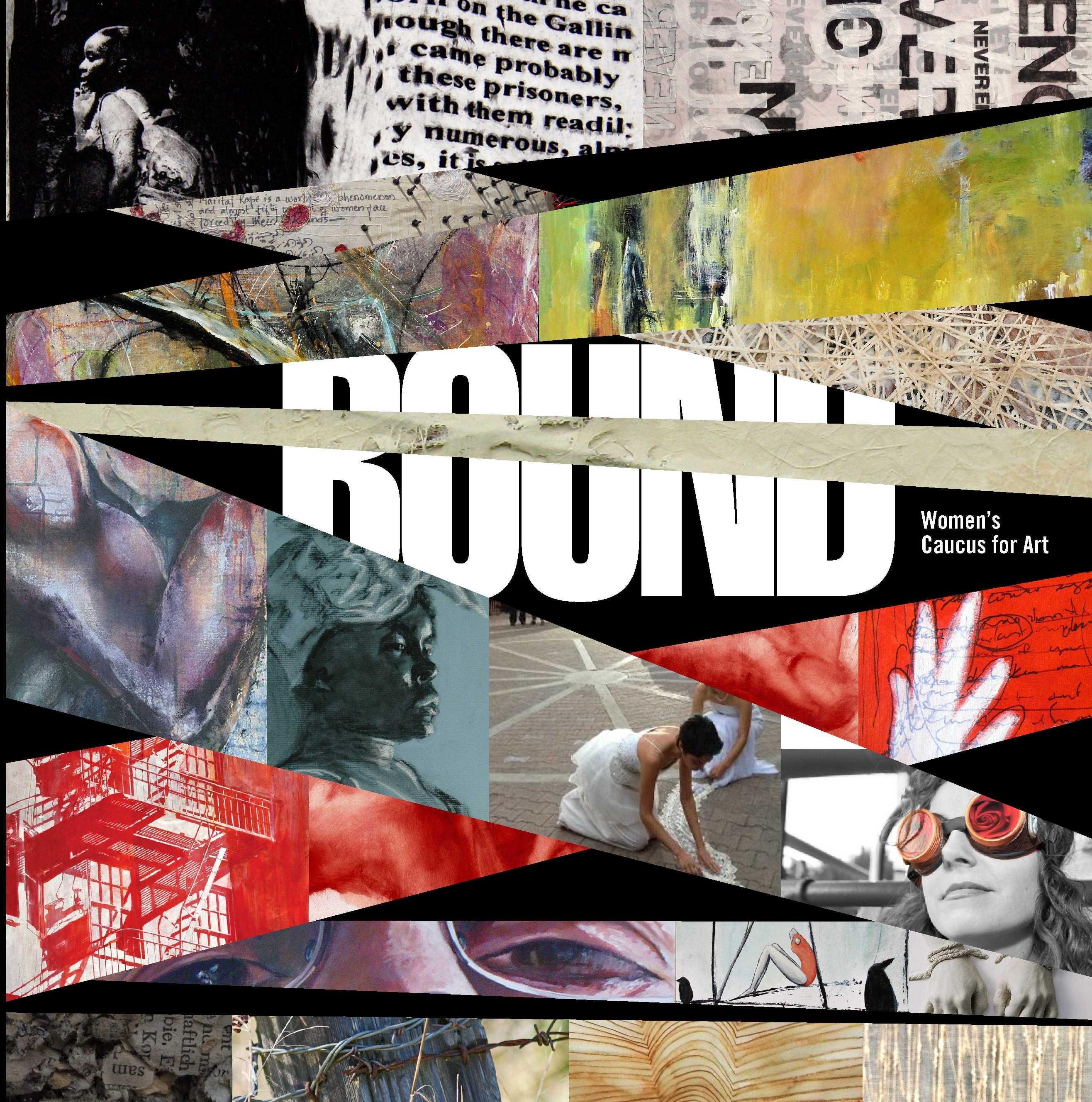
Copyright 2013 by the Women’s Caucus for Art. The book author and each artist here, retains sole copyright to their contributions to this book.
Catalog designed by Karen Gutfreund, Vice President and National Exhibition Director, WCA
Edited by Mollie Dezern, WCA Exhibitions Editor
Cover Design by: Rozanne Hermelyn, Arc and Line Communication and Design. www.arcandline.com
Printed by: Instant Publishers, www.instantpublishers.com
ISBN: 978-0-9831702-8-0
2
BOUND
National Juried Exhibition
Presented by the Women’s Caucus for Art Juror
Cora Rosevear
Associate Curator of Painting and Sculpture
The Museum of Modern Art at Phoenix Gallery
210 Eleventh Avenue at 25th Street New York, New York
January 30—February 23, 2013
3
FROM THE PRESIDENT
Congratulations to the artists in Bound, the 2013 WCA National Juried Exhibition! From the record number of submissions, it is clear that this theme resonated across the United States. I viewed all of the works submitted, and marveled at the many creative interpretations of the theme, ranging from personal, psychological and physical boundaries to social commentaries. As juror, Cora Rosevear had to make difficult decisions based on the physical dimensions of the gallery and the relationship of the pieces to form a cohesive exhibition. The fact that she picked more than 100 additional pieces for inclusion in the catalog speaks to the large number of works that fulfilled her vision of Bound.
Bound is a National Exhibitions Initiative. Chaired by VP Karen Gutfreund, this initiative provides year-round exhibition opportunities for members and women artists. In addition to nationally-sponsored shows, the initiative provides communication and resource support for exhibitions mounted by internal caucuses. The National Exhibitions Initiative produced Petroleum Paradox, Man as Object: Reversing the Gaze (traveling show), Woman + Body, Best of 2012, Artist of the Month, Bound, and Diaspora. It also awarded a curatorial grant to Jaimianne Amicucci to mount an exhibition in San Francisco in 2013.
Bound is held in conjunction with Building Community, WCA’s 41st annual conference. This conference includes a sister exhibition, Diaspora, sponsored by the Jewish Women Artists Network, as well as a workshop, Brunch with Luminaries, Chelsea tour and the Lifetime Achievement Awards and gala honoring Tina Dunkley, Artis Lane, Joan Semmel, and Susana Torruella Leval. Leanne Stella will also be honored with the President’s Award for Art and Activism.
I would like to thank juror Cora Rosevear for her time and vision, Exhibitions Chair Karen Gutfreund for her leadership and tireless commitment to exhibiting women’s art, and Exhibitions Committee members, Trudi Chamoff Hauptman and Mollie Dezern for their excellent administration and catalog work on this exhibition. Thank you Linda Handler of the Phoenix Gallery for providing the venue for Bound.
 Priscilla Otani, WCA President
Priscilla Otani, WCA President
4
ABOUT THE WOMEN’S CAUCUS FOR ART
The Women’s Caucus for Art was founded in 1972 in connection with the College Art Association (CAA). WCA is a national member organization unique in its multidisciplinary, multicultural membership of artists, art historians, students, educators, and museum professionals.
The mission of the Women’s Caucus for Art is to create community through art, education, and social activism. WCA is committed to recognizing the contribution of women in the arts; providing women with leadership opportunities and professional development; expanding networking and exhibition opportunities for women; supporting local, national and global art activism; and advocating for equity in the arts for all.
As an NGO (non-governmental organization) of the United Nations, the Women’s Caucus for Art actively supports the UN Millennium Goals. WCA utilizes art as the universal language to engage artists, NGOS, and civil society on a broad range of issues such as gender equity and environmental sustainability.
As a founding member of the Feminist Art Project, WCA is part of a collaborative national initiative celebrating the Feminist Art Movement and the aesthetic, intellectual and political impact of women on the visual arts, art history, and art practice, past and present.
OUR MISSION
The mission of the Women’s Caucus for Art is to create community through art, education, and social activism.
We are committed to:
recognizing the contributions of women in the arts
providing women with leadership opportunities and professional development
expanding networking and exhibition opportunities for women
supporting local, national, and global art activism
advocating for equity in the arts for all
For more information visit: www.nationalwca.org
P. O. Box 1498, Canal Street Station, New York, NY 10013-1498
info@nationalwca.org, Tel: 212.634.0007
www.facebook.com/groups/107511953206/ twitter.com/#!/artWCA
5
FROM THE EXHIBITION DIRECTOR
Art can be a powerful, productive force and instrumental in sparking change or critical thinking. The Women’s Caucus for Art is committed to supporting local, national, and global art activism. Art can produce a visceral response and can provoke, inspire, or disturb, and opens your eyes to worlds other than your own. While the artist may not consider themselves to be a revolutionary, by bringing to light issues and concerns, art can effect change. We need artistic expression that help us to understand what is happening in our society, who we are, where we come from and where we’re going.
With our prospectus for we asked for work on multiple expressions of “Bound”, that could range from literal to poetic, abstract to representational, and psychological to social and political commentary. We sought to show work that explores the concepts of bound and borders be they internal, external, constructed, imagined, imposed, or embraced and how boundaries define and shape our identities, relationships, ideas and politics. Cora Rosevear, Associate Curator of Painting and Sculpture, Museum of Modern Art, chose 140 artists for Bound with 25 works in the Phoenix Gallery and an additional 118 featured in the catalog. This show is in collaboration with the Phoenix Gallery. We are honored to work with these artists and to showcase their work. We believe in the power of artists to create, connect, and change the world.
Thank you to Linda Handler at the Phoenix Gallery for partnering with us to put on this exhibition and Cora Rosevear for compiling an incredible body of work on this theme from over 400 artist submissions.
A huge thank you to Trudi Chamoff Hauptman, the co-director for this exhibition for her excellent logistical and planning assistance, and to Mollie Dezern, our Exhibitions Editor and Administrative Assistant. As always, thank you to Rozanne Hermelyn for the fabulous catalog cover design. And most of all, a heartfelt thanks to the Board and members of Women’s Caucus for Art for their ongoing work to create greater exposure for women in the arts and art as activism.
Karen Gutfreund Vice President National Exhibitions Director Women’s Caucus for Art
6
ABOUT THE JUROR:
Cora Rosevear was educated at Skidmore College and the Courtauld Institute, University of London. After graduate work at the Courtauld, she was hired by The Museum of Modern Art, where she continues as a curator in the Department of Painting and Sculpture.
During her years at the Museum, she has directed many temporary exhibitions, including those of such artists as Alice Aycock, Balthus, Bernd and Hilla Becher, Robert Breer, Michael Hurson, Louise Lawler, Sol LeWitt, Giulio Paolini, Morgan Russell, Kurt Schwitters and Robert Whitman. She has also been responsible for numerous collection exhibitions devoted to contemporary and earlier art. These include exhibitions of recent acquisitions, memorial tributes, as well as larger, comprehensive exhibitions of the Museum’s collection, and installations of the outdoor Sculpture Garden. As well she has been responsible for many reinstallations of the Museum’s permanent collection galleries. She also supervises the Museum’s outgoing loan program, involving in-house activity, in addition to complying with requests from all over the world.
7
In judging the works of art submitted for this year’s Women’s Caucus for Art exhibition, the request was to have the pieces fit the theme of “Bound,” and I have made every endeavor to do that, even where the premise seemed more implicit than explicit. This was balanced with evaluating the quality of the art works proposed. I hope the result will provide a stimulating presentation of excellent works of art. Many thanks to all the talented artists for their submissions.
“BOUND,” the theme for this year’s exhibition, has yielded a multiplicity of creative solutions to this notion. Paradoxically the concept of “bound,” as exemplified by the entries, has provided open-ended possibility for interpretation and visualization in painting, sculpture, photography, and video, etc. Some of the related meanings connected with the word “bound” range from the literal to the abstract. Thus, the word when used concretely can apply to strings, cords, or ropes – anything, that is, that serves to tie something up. Not only things, but also persons can be tied up for better or for worse. One cannot help but think innocuously of packages or, on a far darker note, of prisoners, etc.
The participating artists have responded in many different, and even ingenious, ways to the theme of “bound.” They themselves have not been “bound” to any formula, but have allowed their imaginations to address ideas pertaining to barriers, limits, restraints, and restrictions without being hampered by aesthetic circumscription. They have eloquently spoken, often metaphorically, in a broad variety of ways, whether about fences, gates, and walls; or about constraints imposed both from within and/or without; or about oppression; about inhibition; about being tied to time and/or memories; and, with direct reference to art production itself, about being bound by the requirements of medium and materiality in and of itself. With much perspicacity, the artists have treated the theme of “bound” on a variety of levels: not only on physical ones, but also on social, psychological, and emotional ones to encompass the personal and the political alike. In doing so, they evince the ability of aesthetic activity to take refuge in the unbounded potential of the imagination to produce objects and images.
This year there were a total of 1060 entries by 417 artists for the exhibition, of which unfortunately only a tiny fraction could be shown in the gallery. Even the catalogue, although including a greater number of works, had to be severely limited for space constraints. Therefore, in both categories a great many extremely fine works of art had to be passed over. We are sincerely sorry that all could not be included.
Cora Rosevear Associate Curator of Painting and Sculpture The Museum of Modern Art
8
JUROR’S ESSAY
ABOUT THE GALLERY
From its origins as a prestigious artist co-operative in New York, celebrating its 50th Anniversary in 2008, the Phoenix Gallery has evolved into a community-oriented center for all the arts. Founded in 1958, during the “Tenth Street” days, the gallery now has artist-members from around the world, all dedicated to the highest level of professionalism. Each brings his/her own unique style and vision to the diverse group that makes up the Phoenix Gallery. These artists, all carefully chosen for membership by Phoenix artist peers, work in all media and create art that encompasses and reflects wide cultural and ethnic interests.
In addition to providing artist-members elegant space to exhibit, the gallery reaches out to the members of the community, scheduling juried competitions, dance programs, poetry readings, book signings, plays and lectures. A special exhibition space, The Project Room, has been established for guest-artist exhibits. The Phoenix Gallery is a non-profit 501-(c) (3) organization.
The Phoenix Gallery has a full time director who runs the gallery and promotes and develops contacts with private individuals, art consultants and corporations. The director also promotes sales and encourages visibility of artist members.

PHOENIX GALLERY MISSION STATEMENT
In continuous operation since 1958, the Phoenix Gallery represents a committed artist community that runs a non-profit public exhibition space for fellow professional and emerging artists. In addition, it awards fellowships, hosts juried exhibitions, and promotes the work of all its members.
9
Milestones over the Four Decades of the Women's Caucus for Art
In the forty years since the Women's Caucus for Art (WCA) was conceived in 1972, opportunities for women in the arts, and knowledge about the accomplishments of women artists throughout history, have expanded dramatically, this is due to the activism and the dedicated efforts of feminist organizations, such as WCA, as well as of individuals, including the WCA founders, leaders, and Lifetime Achievement Award honorees. For four decades WCA members have worked to recognize the contributions of women in the arts and to educate the public about them, as well as to expand networking, exhibition, and leadership opportunities for women.
By 1972, in the second wave of feminism, the feminist art movement has been launched. When the WCA was conceived during the January 1972 College Art Association meeting in an overflowing room in San Francisco, only a few women had ever served on the CAA board of directors and most tenured college professors were male, even though at least half of the studio art and art history majors in colleges and graduate programs were female. Not even one female artist was included in the major at history survey textbooks.
WCA's founders were artists and art historians, with art historians taking the initial leadership roles. The first chair, art historian Ann Sutherland Harris, created a structure for the organization, started collecting dues, and launched a newsletter. Norma Broude was the Affirmative Action Officer. The next president, Mary Garrard, assisted by Secretary Ellouise Schoettler, established the Women's Caucus for Art as an incorporated non-profit with a national advisory board, and convinced CAA to accept WCA as an affiliated society. Since the late 1970's CAA has provided meeting times and spaces for WCA during its winter conference, and a number of WCA leaders have served as CAA presidents.
One of them was the third WCA president, Judith K. Brodsky, who co-founded the Coalition of Women's Arts Organizations (CWAO), first chaired by Ellouise Schoettler, which allowed WCA to join with 75otherorganizations to lobby Congress to organize political actions. WCA first published course syllabi in Women's Studies in the Arts compiled by Athena Tacha, while Eleanor Dickinson began an ongoing effort to gather and publish statistics documenting discrimination in the art world.
In 1977 WCA held its first national conference and first national exhibition in Los Angeles in conjunction with the CAA conference. That year, attendees saw Linda Nochlin and Ann Sutherland Harris' groundbreaking museum exhibition Women Artists: 1550-1950.
10
In 1979, through the efforts of president Lee Anne Miller and conference chair Charlotte Robinson, with the help of Joan Mondale, the first Honor Awards for Lifetime Achievement in the Visual Arts were presented by President and Mrs. Jimmy Carter at the White House to Georgia O'Keeffe (in absentia), Louise Nevelson, Alice Neel, Selma Burke, and Isabel Bishop, followed by a repeat ceremony for WCA members at the conference.
The women artists honored at the first ceremony were the first in a distinguished roster of outstanding artists, art historians, curators, educators, critics, and other visionaries who have been honored each year. Their life stories and accomplishments are documented each year in an awards catalogue and they receive lifetime WCA memberships. Also, during the 1979 CAA and WCA conferences, WCA members encouraged dozens of galleries, colleges, and universities to mount exhibitions of women's art in the D.C. Area. In addition, a gallery exhibited the work of the awardees.
In 1980, when the CAA conference was held in New Orleans, a state that had not yet ratified the Equal Rights Amendment (ERA), WCA members who attended the WCA conference endeavored to spend no money in the state, and to support ERA, conceived the whole conference as a performance under the guidance of Suzanne Lacy. Concurrently, an alternate WCA/CWAO awards program honoring feminist activists was held in Washington, D.C.
By 1982, the end of its first decade, WCA had grown. Over the years, the number of WCA chapters spread across the country had averaged about 30. In 1984, under the sixth president, Muriel Magenta, a permanent office and national administrator was set up at the Moore College of Art in Philadelphia. The office would serve as a clearing house for information, house the archives, and allow to build a comprehensive slide library of women's art. Annie Shaver-Crandall oversaw the establishment of the WCA archives at Rutgers University.
In the mid-80s, more attention was paid to diversity and inclusion and recognition of women of color. The first President's Awards to mid-career women were presented to Ann Sutherland Harris and Linda Nochlin. During the 1987 conference in Boston, over sixty academic and commercial galleries showed work by women artists. The Boston chapter membership doubled in size to over two hundred, with artists, curators, and art historians working closely together. In 1992, at its twentieth anniversary, WCA was energized by the vision and goals of the twelfth president, Jean Towgood, who established a Vice President of Women of Color. The curated Women of Color in the Arts Slide Series was made available to provide resources for teachers and slide collections, and a Women of Color caucus was formed. The Jewish Women Artists Network (JWAN) caucus followed in 1991. WCA also became a United Nations NGO, and one hundred WCA members participated in the 1995 International Conference on Women, and NGO Forum of the UN, and
11
traveled to China. WCA has retained its NGO status throughout the years with members attending the conferences in 2008, 2009 and 2011. At the 2009 UN conference, WCA proposed and participated in a workshop, one of the only twelve selected. Today several chapters, especially the Oregon chapter, participate in international exchanges on a regular basis.
In the late 90s, WCA survived a period of crisis caused by a series of financial and operational losses that put the survival of the organization in doubt. The organization, primarily funded by dues, was not sufficiently focused on fiscal matters, budgeting an accounting. Losses were incurred when WCA tried having a conference in Philadelphia separate from CAA in New York in 1997. At the same time the decision was made to increase the visibility of WCA by moving the national office to New York City where CAA conferences were held every other year. The theft of valuables and loss of records left the organization close to bankruptcy. However, a few members remained strongly committed to the WCA mission. With the help of volunteer lawyers, the cooperation of creditors, and a fundraising auction of donated art the continuation of WCA was ensured. A transitional leadership committee (Magi Amma, Catherine Carilli, Margaret Lutze, Gail Tremblay) managed to pay off all debts, and Gail Tremblay was elected as interim president.
In 1999, the Los Angeles chapter let by Jean Towgood organized a successful national conference and an awards ceremony during the CAA conference. During the presidency of Magi Amma, also based in California, work was undertaken to rebuild the member database, revive the newsletter, and establish a website.
In 2002, President Noreen Dean Dresser moved the national office from California bac to New York and hired Karin Luner as the national administrator. Luner worked on streamlining the organization, getting the membership records back in sync with chapter records, redesigned the website, established an online member directory, and designed the publications. Soon thereafter membership rebounded, and Dresser continued Amma's efforts to strengthen connections with chapters. Dresser's successor, Dena Muller (20042006), arranged for a small national office at Rutgers University, returning the office to a university setting. In 2005, she collaborated with the CAA Committee on Women in the Arts on a joint awards ceremony in New York. During her tenure, WCA became a founding partner of The Feminist Art Project (TFAP), which documents and celebrates the feminist art movement. In recent years TFAP has provided a full day of panels about women's aesthetic and intellectual impact on the cultural record during the CAA conference.
During Dena Mueller's and Jennifer Colby's (2006-08) terms, the full-fledged conference organized by the Boston chapter in 2006 demonstrated how meaningful WCA had become. The conference consisted of sixteen panels and seventy presenters and was captured on video. It included a festival of video shorts, as
12
well as five exhibitions. Karen Frostig and Kathy Halamka edited and oversaw the publication of the session papers and other essays in BLAZE: Discourse on Art, Women and Feminism, Eleanor Dickinson's “Report on the History of the Women's Caucus for Art” was the first comprehensive written history of the organization. Besides overseeing two successful conferences, Colby focused on board leadership development and the concept of legacy. In the past decade, the organization has maintained and increased financial stability, with revenue doubling in the past two years under Janice Nesser-Chu (2010-2012). Fund-raising for the award ceremony and chapter programs has received increasing focus from the president and the board since the presidency of Marilyn Hayes (2009-2010). Under Hayes and Nesser-Chu, the mission statement was revised.
Under Janice Nesser-Chu's leadership the WCA's focus has been on activism, outreach, and engagement with chapters. Two summer regional conferences were held to coincide with the summer board meetings, Eco-Art in 2010 and Art & Social Justice in 2011. The newly established Eco-Arts caucus grew out of the 2010 Pacific Regional Eco-Art Conference “Elements”. The Young Women's Caucus (YWC) was formed by a group of college art students to provide networking resources to women under 39 years of age, and to mentor new leaders. The International Committee was converted to a caucus at the recent summer board meeting in 2011. New chapters were formed in New York and Texas, and a chapter leadership fund was implemented.
Also under Nesser-Chu's tenure, the financial foundation of the organization was strengthened, providing momentum for future growth, Nesser-Chu launched a legacy campaign with a generous bequest from the Estates of Sylvia S. Alloway. Sylvia Sleigh was selected to receive a Lifetime Achievement Award in 2011, but she sadly passed away before the awards ceremony. Since then, the Estate has donated several of Sylvia's works to WCA and has worked with WCA to place several of her pieces in museums and institutions. Going forward, WCA will provide fiscal receivership for her estate, administering charitable contributions.
Today, the over 1600 members value the organization for creating connections with other women in the arts, stimulating new ideas and initiatives, providing exhibition and curatorial opportunities, developing leadership skills and experience, and serving as an avenue to reach out to their communities. The website, the online directory, calendar, blog, twitter, Facebook pages enable members to easily connect with each other across the country.*
by Barbara A. Wolanin
Barbara Wolanin is an art historian and curator. She has been a member of WCA since 1978. She has been active in the D.C. Chapter since 1990 and has served on the national board since 2002.
*Sources for essay are published at www.nationalwca.org/aboutwca/history.php
13
BOUND EXHIBITION COMMITTEE
Karen Gutfreund
Trudi Chamoff Hauptman
Mollie Dezern
Advisory: Sherri Cornett, Sally Edelstein, Carla Goldberg, Sandra Mueller, Priscilla Otani and Jeane Vogel

WCA 2011-13 Board
Executive Committee
President
Priscilla Otani, Artist, Partner Arc Studios & Gallery, San Francisco, CA
President-Elect & WCA Chapter Community Initiative
Brenda Oelbaum, Artist, Independent Curator, Ann Arbor, MI
Treasurer/Secretary
Margaret Lutze, Adjunct Faculty, Northwestern, DePaul, and Loyola Universities, Chicago, IL
Vice President & Chair WCA National Exhibitions Initiative
Karen Gutfreund, Curator, Art Consultant, Artist, San Jose, CA
Past President & Chair WCA Legacy Initiative
Janice Nesser-Chu, Professor, Director of the Galleries & Perm. Collection, Florissant Valley College, St. Louis, MO
VP Chapter Relations
Ulla Barr, Artist, San Clemente, CA
VP Organizational Outreach
Ally Richter, Artist, Chair Palo Alto Public Art Commission
VP Development
Fay Grajower, Artist, Independent Curator, Member of Dreyfus Foundation Board of Advisors, University of PA
Staff
Director of Operations - Karin Luner, Artist, Gallery Director, Dietzspace, NYC
14
The Feminist Art Project (TFAP) is an international, collaborative initiative recognizing the aesthetic, intellectual and political impact of women on the visual arts, art history and art practice, past and present. TFAP promotes diverse feminist art events, education, resources and publications through its website and online calendar, and facilitates networking and regional program development worldwide.

The Feminist Art Project brings together artists, curators, scholars, authors, teachers and other art and museum professionals across cultural backgrounds, generations and widespread locations to refocus public attention on the significant achievements of women artists and the contemporary Feminist Art Movement.
TFAP National Committee: Judith K. Brodsky, Judy Chicago, Kat Griefen, Leslie King-Hammond, Catherine Morris, Dena Muller, Ferris Olin, Arlene Raven (1944-2006), Maura Reilly, Susan Fisher Sterling, Anne Swartz
TFAP Honorary Committee: Norma Broude, E. John Bullard, Connie Butler, Mary D. Garrard, Chrissie Iles, Arnold Lehman, Lucy R. Lippard, Margo Machida, Cindy Nemser, Linda Nochlin, Faith Ringgold, Lowery Stokes Sims, Gloria Steinem
TFAP Founding Program Partners: A.I.R. Gallery, ArtTable, Brodsky Center for Innovative Editions, College Art Association, Elizabeth A. Sackler Center, Brooklyn Museum, Institute for Women and Art - Rutgers University, Maryland Institute College of Art, National Museum of Women in the Arts, Rutgers University Libraries, Through the Flower, Women’s Caucus for Art
TFAP PROGAMS INCLUDE:
TFAP On-line Calendar and Archives aims to effect permanent change by promoting and archiving exhibitions, performance, lectures, films, and other events and publications that recognize the work of women artists, feminist content in art, feminist art practice, the impact of feminism on the art world and feminist analysis in art and art history and other cultural arenas. Artists, scholars, groups and presenters may post their national and international exhibitions, publications and programs that serve this mission on the TFAP calendar. It is free of charge to post and search the calendar. TFAP preserves all calendar listings in the TFAP virtual archives and requests physical documentation from calendar participants to add to The Feminist Art Project Archives to be held in the Miriam Schapiro Archives at Rutgers University for future scholarship on feminist art and feminist art organizations.
15
Feminist Art Resources in Education (FARE), an online resource portal providing unlimited free public access to educational materials that utilize feminist art, theory and history to empower students, youth and adults to think critically about the social issues that shape their lives. Visitors to FARE can access curricula and teachers’ guides from proven programs that can be downloaded and adapted for use in classrooms, after-school programs, community projects, home school projects and more. FARE links to websites and multi-media resources that complement the curricula available on FARE and can be used in creating distinctive hands-on class projects. FARE also connects to a comprehensive network of art programs on women and gender being implemented across the country, and provides reading resources on feminist art, current trends, significant accomplishments of women artists and topics of gender and art.
TFAP Regional Coordinators - TFAP supports regional networking and program development by linking from the website to over 40 national and international coordinators. Coordinators act as conduits for those needing general information or interested in being involved with a local TFAP group, and initiate programs in their areas.
TFAP@CAA - TFAP presents a diverse set of panels, performances, gallery talks and tours that attract anyone interested in contemporary art and ideas. These events offered under the umbrella title of TFAP@CAA, coincide with the annual College Art Association conferences taking place in various U.S. cities. Through these programs, the general public, art community, and emerging art professionals gain access to cutting edge work and ideas of artists, curators, performers and scholars, up close and through a feminist lens and participate in ongoing forums for feminist issues and discussions of global art and art history. All events are free and open to the public.
The Feminist Art Project is a program of the Institute for Women and Art (IWA), Rutgers University. The IWA is a unit of Rutgers, the State University of New Jersey, and a center of the Office of the Associate Vice President for Academic & Public Partnerships in the Arts & Humanities.
For more information contact:
The Feminist Art Project, Institute for Women & Art Rutgers University
191 College Ave, 2nd Floor, New Brunswick, NJ 08901
tfap@rci.rutgers.edu
848-932-3726
Visit feministartproject.rutgers.edu
16
BOUND ARTISTS
* denotes artists exhibited at the Phoenix Gallery
17
Feminine Transcriptions. Acrylic on paper with sewing patterns and spray paint. 30 x 22 inches. 2011
Feminine Transcriptions explores how the body tries to make sense of a fragmented space that is in flux. The collages consist of fragments of sewing patterns, which are used as metaphors for the body as it is constructed by culture, with its predetermined sizes, seams and biases. As metaphors for the body, they operate within the confines of narrow and predetermined parameters. However, the sewing patterns also operate as architectural blueprints that point to a place that is fluid, fragmented and unknown.
 Olga Alexander
Olga Alexander
17
Dara Alter
My autobiographical landscape paintings examine place through the use of cartography, architecture, and chance. In the work, I explore boundaries of representation and abstraction. I omit the ground, allowing a place to float mid-air. To contemplate a location, I merge experiential properties with physical borders. The experiential aspects enter the work through pockets of abstraction that weave over, behind, and through representational matter. Finally, the work finds itself on the boarder between place and non-place.
 Gathering of Brothers. Acrylic on canvas. 16 x 20 inches. 2012
Gathering of Brothers. Acrylic on canvas. 16 x 20 inches. 2012
18
Suzanne Anan
Suzanne Anan is an American artist who creates figurative compositions primarily reflecting women as her subject. She creates in all mediums, but prefers the unpredictable results that painting serves to project the humility and vulnerability created with every stroke of oil onto canvas. Her work Woman In Blue, appears to be trapped in her own body. Her eyes appear to be looking upward. Has she acquiesced, or is it pride? These evocative images resonate moods and memories and question what it means to feel human.
 Woman In Blue. Oil on canvas. 20 x 30 inches. 2012
Woman In Blue. Oil on canvas. 20 x 30 inches. 2012
19
MGP Andersen
Our bodies, our appetites and our relationships bind us. New products, chemicals and religions (every new relationship is a new religion) promise to free us, but I don’t believe we can be freed. All we can do is be aware of the problem and help each other with the tightest bonds. Sufficient depicts a common prison: the trap of what is just okay.
 Sufficient. Oil on canvas. 16 x 12 inches. 2011*
Sufficient. Oil on canvas. 16 x 12 inches. 2011*
20
Joan Arbeiter
Can Anything Be Better Than Tide. Mixed media assemblage in Plexiglas shadow box. 21.75 x 17.25 x 2.25 inches. 2004
It took the Women’s Movement to help me to see these cute snapshots as a record of my being bound by prevailing gender roles. There are three main elements in this mixed media assemblage, beginning with a vintage photo of me during my formative years, then documents the time-frame in question with an authentic period magazine illustration and finally, updates and completes the message by including position statements from contemporary feminist books and periodicals.

21
Katherine Armacost
This work explores imposed boundaries. As a teen in the 1950s, I wore as many under garments as outer: bras, girdles, dress shields, garter belts, plus other belts for that time of month. I remember feeling tied up, stiff, restricted, corseted and, to some degree, breathless. In this work—which was fun to do—I untied the corset, took a deep breath and “let loose”.
 Literal. Gesso, handmade paper, yarn on panel. 12 x 12 inches. 2012*
Literal. Gesso, handmade paper, yarn on panel. 12 x 12 inches. 2012*
22
Maria Barbachano
During atrocities in Argentina (1976-1983), 30,000 people disappeared over the course of seven years. The Argentinian Navy would fly ‘missions’ over the ocean and throw drugged kidnapped victims out of planes in a horrific act of inhumanity. At the bottom of the ocean lie possibly thousands of remains. These souls are bound to the bottom of the ocean as the sand and water have flowed over them for decades. These drawings are a topographical map of the disappeared, where lines bind the body to the page.
 The Lovers. Watercolor pencil on paper. 42 x 32 inches. 2010*
The Lovers. Watercolor pencil on paper. 42 x 32 inches. 2010*
23
Temme Barkin-Leeds
While “shooter” style video games are intended for entertainment for a young audience, they are especially addictive and tend to BIND the player to the console. I make them unable to operate in this way. I use their images as source material and put them on a 2-D surface. I abstract them, flatten them, and introduce images of Americana—baseballs, ice cream cones—to highlight the absurdity of using real war scenes as game material. I bind the images to counteract the games’ ability to bind the player.
 Arrested Frame with Baked Turkey. Acrylic on gessobard. 16 x 20 inches. 2012
Arrested Frame with Baked Turkey. Acrylic on gessobard. 16 x 20 inches. 2012
24
Mariona Barkus
Do You Know Too Much? Archival digital print. 20 x 20 inches. 2012
Dread the daily onslaught of text messages, emails, tweets, or status updates? Yeah, but who can resist their siren song for very long? Do You Know Too Much? depicts modern day techno-bondage.

25
Mariana Barnes
We are a nation of immigrants. Our ancestors put their lives on the line in their quest for a better life. We reap the benefits, but sometimes forget that others ought to have the same rights. We are all united by a common goal: the pursuit of the American Dream. We all bring a piece of the world to share with each other every day. We bring together our cultures, our colors, our beliefs and our spirits. Let our nation be a place where the world meets without borders.
 The Melting Pot. Acrylic on canvas. 41 x 31 inches. 2006
The Melting Pot. Acrylic on canvas. 41 x 31 inches. 2006
26
Aileen Bassis
Prisoners. Photopolymer etching. 8.25 x 11.5 inches. 2009
My work is based in photography and often includes text. I am interested in content in art and in particular, reexaminations of the world; the reality around us. Like many, I was intensely involved in the 2008 Presidential election, which started me thinking about the legacy of slavery in the United States shaping racial relationships. The realities of race in America are like a scab that never heals, and keeps bleeding anew. This work combines urban street images with fragmented historical texts and legal decisions.

27
Jacqueline Bennett
Fragile Capacity. Water based oil on canvas. 24.5 x 24.5 inches. 2012
Fragile Capacity explores the mysterious beginning place: the vanishing marker, making the meeting-point where our connections begin; binding us to this earth, ourselves, each other, and the human experience. Capacity to see through the subjective time layers is fragile. Formed over shifting circumstance, we make the nuanced, subjective picture we call our story.

28
Lauren Bettini
My art is a direct response to my personal experiences with domestic violence. While creating this work I wanted to convey feelings of confinement, helplessness, and suppression through positioning the female figures in an enclosed space. The women are being restrained by a thick band that tangles around them, and prevents their escape. They are no longer in control of their own bodies, but controlled by the force that binds them.
 Bound 13. Ceramic. 20 x 30 x 4 inches. 2012
Bound 13. Ceramic. 20 x 30 x 4 inches. 2012
29
Suzanne Beutler
My pictures, taken in Pune and Bangalore, India, illustrate how people are bound by poverty. In Amazonian Interior, I felt that the woman was bound to her home, which she must protect and which gives her identity. Her husband and sons can leave to work in the cities, but she must stay home.
 Amazonian Interior. Oil on canvas. 30 x 40 inches. 2011
Amazonian Interior. Oil on canvas. 30 x 40 inches. 2011
30
Kelly Blevins
To be alone is to think. Feelings can become intensified beyond belief, and the reflections we see are scary and beautiful. Some lives are better-lived in solitude; a life dedicated to creating a mirror image of the world, even as we are bound by ironies that breathe down our necks. Taboo chains our spirits to nothing, and our terror becomes the fascination that drives us through this life.
 Fabric. Charcoal on paper. 48 x 36 inches. 2012
Fabric. Charcoal on paper. 48 x 36 inches. 2012
31
Barbara Boissevain
As caretakers of our environment we are bound to the missteps of our predecessors. Hangar One is an iconic colossal structure that is also the largest Superfund site in the Silicon Valley. Rife with controversy, it was recently found to be leaking toxic chemicals into the San Francisco Bay. These aerial shots depict the resulting biological die-off of the wetlands in close proximity to the hangar. The intent of this work is to cultivate awareness and provoke meaningful discourse about environmental stewardship.
 Ghost Hangar No.3. Archival inkjet digital print. 40 x 23 inches. 2012*
Ghost Hangar No.3. Archival inkjet digital print. 40 x 23 inches. 2012*
32
Andrea Broyles
In this series I was interested in the idea of an open cage, where there is a way to escape and, ultimately, a choice. I used simple shapes that originate from Asian fish traps. The fish enter because the space looks permeable, but then are trapped and either killed or die. The spaces that I created allow the viewer to image staying or going; if they stay and are trapped, bound to the space, it is by choice.
 Cage Series II. Acrylic on paper. 12 x 10 inches. 2010
Cage Series II. Acrylic on paper. 12 x 10 inches. 2010
33
Corliss Chastain
Odalisque. Oil paint stick, oil pastels, colored pencils, collage, metallic thread. 22 x 30 inches. 2001
The impulse that drives this imagery originated from a narrative of personal despair. Images and layers of materials form a frieze-like framework to be read like stanzas or paragraphs. The naked, bound figure in Odalisque is “poked and prodded” into submission. Bound by golden treads of intent, the figures are restrained and confined to boxes of consequence.

34
Kieran Collins
My works are influenced by the liminal rites of passage of indigenous societies. I juxtapose ritualistic elements in a contemporary environment to deprive them of their cultural and temporal context, allowing for investigation of conscious and subconscious associations. In contemporary Western society, our identities are adhered egocentrically to our memories. This is reflected in our perception of symbols and the unique narrative we construct. Reflecting upon these archetypes allow for greater understanding of the Self.
 Betrothal 1: Bashkir Rite. Found image transfer and oil on panel. 24 x 36 inches. 2012
Betrothal 1: Bashkir Rite. Found image transfer and oil on panel. 24 x 36 inches. 2012
35
Jeannine Cook
In Distant Traces II: the Sarmento depicts a dry river bed in Italy where barriers and dykes constrain and bind winter floods into coherency. The river is “bound” and constrained, bound while trying to follow the lay of the land; an expression of personal experience of the theme.
 Distant Traces II: the Sarmento. Silverpoint on prepared paper. 14 x 18 inches. 2012
Distant Traces II: the Sarmento. Silverpoint on prepared paper. 14 x 18 inches. 2012
36
Marcia Cooper
I perceive ‘Bound’ as implicit with contradiction and tension, simultaneously implying opposites; movement and constraint, being connected to the earth and reaching up to the celestials.
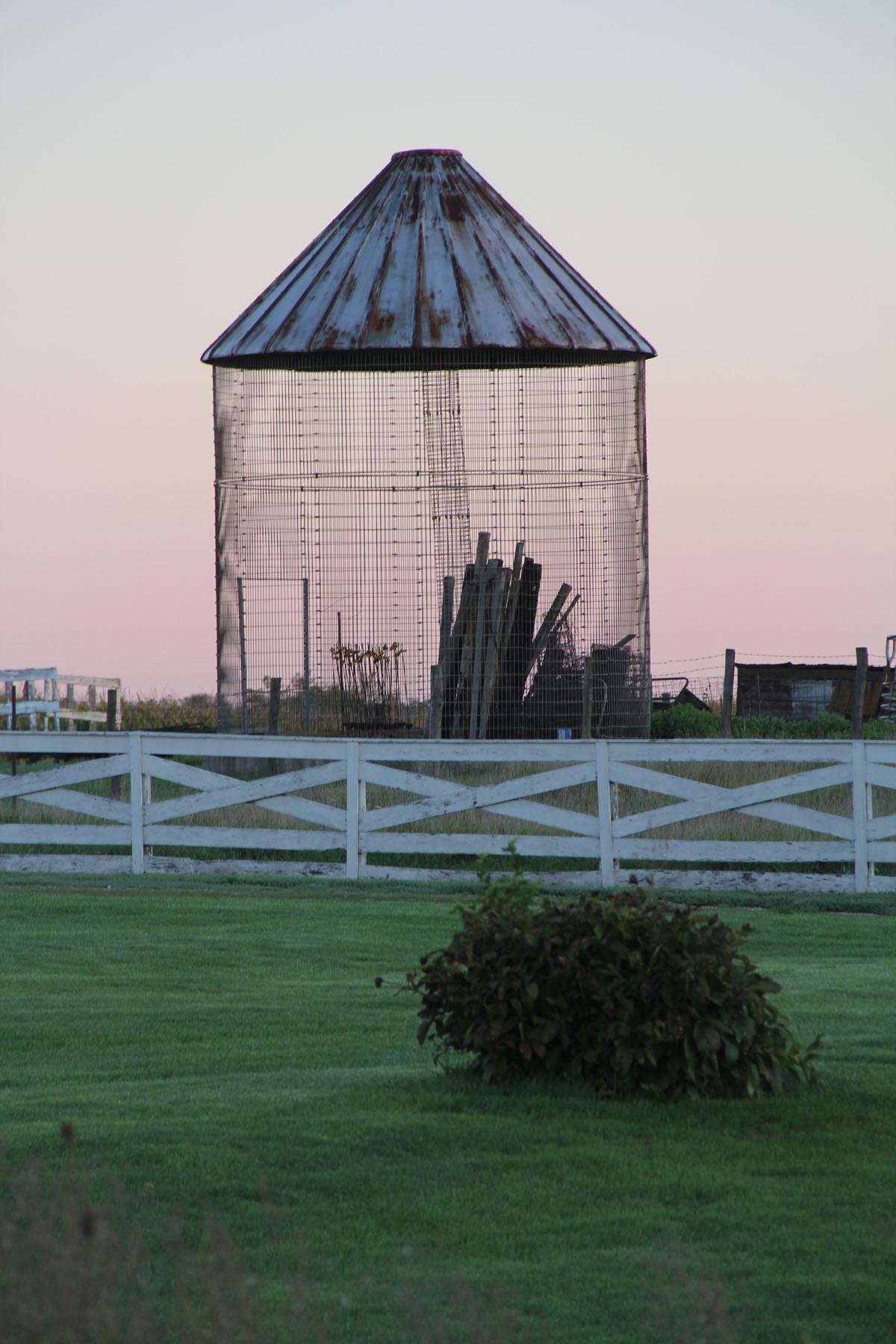 Untitled 1. C-Print mounted. 30 x 20 inches. 2012
Untitled 1. C-Print mounted. 30 x 20 inches. 2012
37
Lauren Cross

Untitled (Unkempt 8). Archival inkjet digital print. 24 x 36 x 3 inches. 2012
I am fascinated by hair by the love of hair, the hate of hair, and drawn to the urge to tame or free our hair. I apply the narrative of moving images; the artist in motion as performer, entertainer, storyteller. In my Unkempt series I explore performance as materiality and subjectivity, through digital photo manipulation. In many ways hair is a cultural signifier that binds us to certain realities and life experiences. I use technology to complicate these so-called stagnancies, and to visualize inner struggles coming to light.
38
Debra Dake-Morrell
Unbound. Graffitied wood and rock. 40 x 38 x 24 inches. 2004
Creative expression cannot be suppressed.
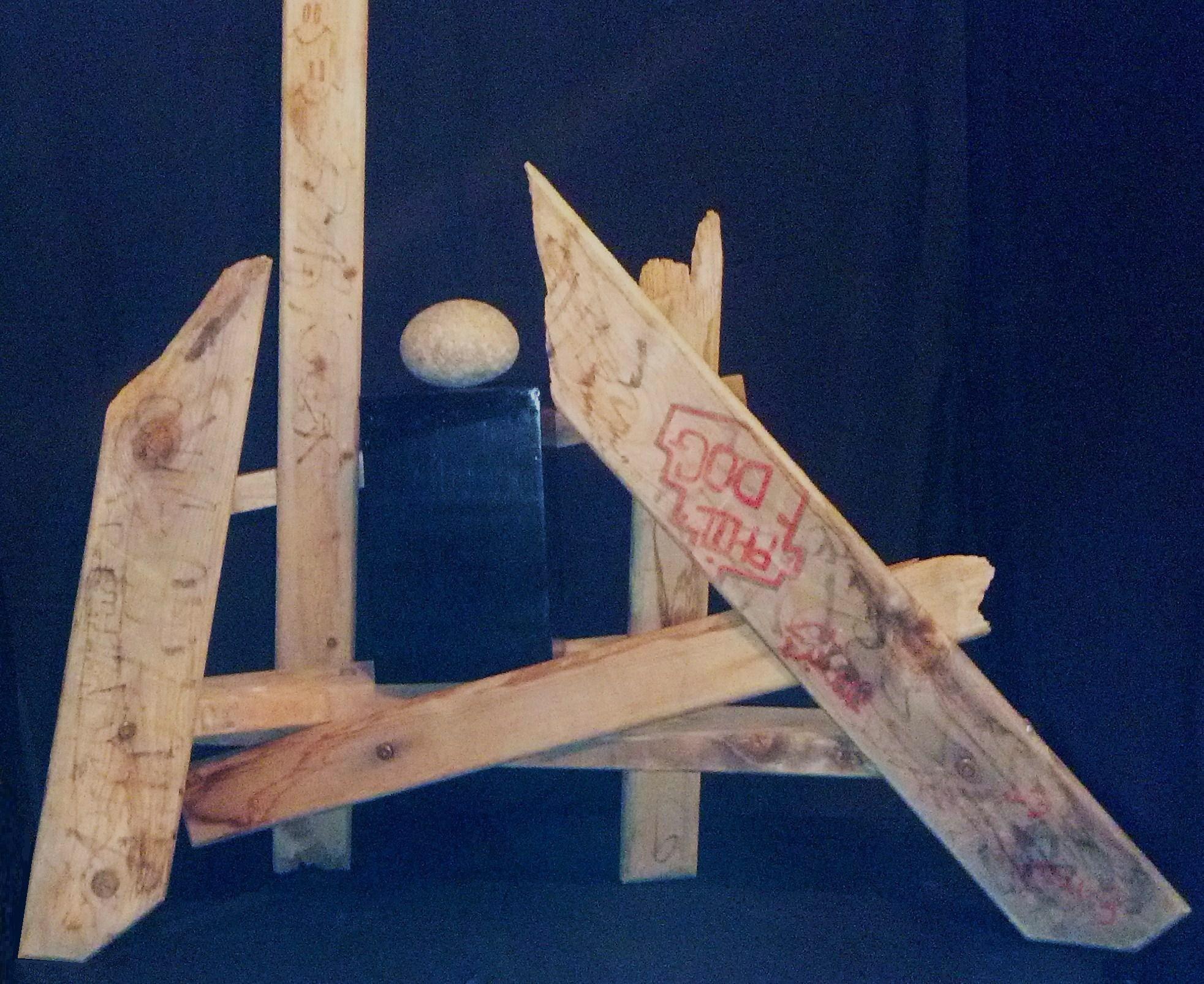
39
Lynn Dau
My work visually expresses reflections on my own personal boundaries. Point of View relates to the permeability of my personal boundaries and how I internalize the feelings, judgments, and behaviors of others.
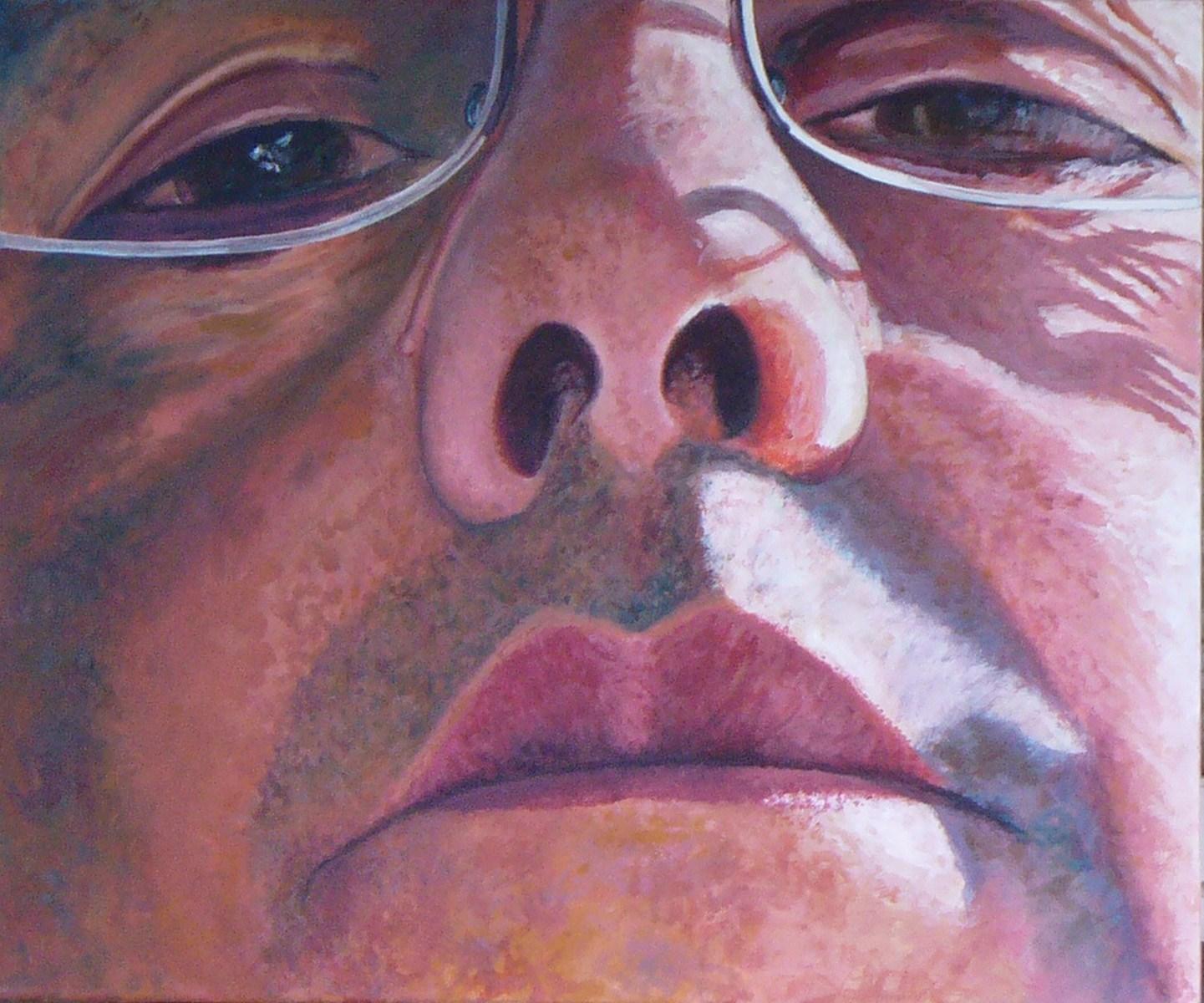 Point of View. Acrylic on canvas. 20 x 24 inches. 2010
Point of View. Acrylic on canvas. 20 x 24 inches. 2010
40
Mary Lou Dauray
Here I Am. Oil on gessoed paper. 30 x 22 inches. 2012
Do I see? Am I restricted? Do I want to escape? Do I choose to be hidden and bound by my clothing? Do I feel safer this way? All I want is peace. This artwork is oil, watercolor and ink on gessoed watercolor paper and is part of a series of women’s faces I have been painting this past year. A memorable visit to Jordan in June, 2012 inspired this particular work.

41
Deborah Davis
Human beings need one another, bound by inescapable emotional threads that connect us infinitely to each other and intimately to our partners. One follows where the other goes, one thinks what the other feels, one remains while the other rests. We will go a great distance to stay bound. Love binds us, yet has no boundaries.
 Couple On Stairs. Archival inkjet print. 13 x 9 inches. 2005
Couple On Stairs. Archival inkjet print. 13 x 9 inches. 2005
42
Yvette Dede
I chose the hand to represent the self for its dynamic physical qualities and for its universality that it does not have to reference a specific individual. The string-tied hand reacts to its constraints with varying degrees of movement. There is a psychological and physical tension between hand and string that suggests the engagement between external forces and internal impulses. The push and pull of will and bond are inextricably tied together. One is bound to the nature of dualities that help define the self.
 Hand #5. Charcoal on paper. 51.5 x 40 inches. 2012*
Hand #5. Charcoal on paper. 51.5 x 40 inches. 2012*
43
Stranded. Digital photography and found object. 10 x 20 inches. 2011
As generation after generation dwell in suburbia, the idea that we are literally bound to the combustion engine—no matter how nostalgic or beautifully it is packaged—is a reality. Will we ever reach the future? Will we ever be released from the shackles of the petroleum industry? Or will we simply always be waiting on the wind?
 Sherri Denault and Margie Glass Sula
Sherri Denault and Margie Glass Sula
44
Laura Di Piazza
These works address the woman with dominant tendencies, who was likely raised to play nice. Here, she enforces control and is anything but nice. She is as bold as her boundaries, and her submissives are willing to stretch. Many men have dominant roles in many areas of our society. Perhaps for balance or to surrender to their already-present servile nature, there are men who like or even love to hang their dominant role on the bedroom door-knob and become their lover’s submissive and obey her every command.
 Kneel. Oil pastels and acrylic paint on canvas. 20 x 20 inches. 2012
Kneel. Oil pastels and acrylic paint on canvas. 20 x 20 inches. 2012
45
Vanessa Diaz
that from which begins its presence. Wooden rails, paint, charcoal. 30 x 18 x 15.5 inches. 2012*
Within the private realm of the home, routine behaviors and habits physically shape the area and objects within—cushions sinking from body weight; scuffmarks on the front door, stains, scratches. Evidence of use is an indication of time past. In this work, dense layers of paint coat the tips of decaying wooden rails, strengthening individual components into a structural a whole. Preserving the dwelling from deterioration requires consistent maintenance, intentional concealment is a sign of resilience.

46
Debra Dobkin
Women of all colors, nationalities, and religions are bound together by our common thread in the tapestry of history. It is one of repression that seems to repeat itself whenever a positive change is near. This painting is my response to the current drumbeat by religious zealots and right wing conservative politicians who would like to deny women control of their own bodies, access to women’s healthcare, contraception, and equal pay ultimately turning back the clock.
 In The Shadows. Oil on canvas. 11 x 9 inches. 2011
In The Shadows. Oil on canvas. 11 x 9 inches. 2011
47
Jennifer Dunlap
You Do Have a Pretty Massive Dome. Graphite and watercolor on paper. 8 x 8 inches. 2012
It is so shameful to have a body any body as a woman. To be too fat or too thin, with wrinkles, acne, scars and all; to show too much or too little; to be too ugly or too beautiful; these pressures are all demoralization and objectification. It’s not a secret or revelation—it feels like a trap half the time. But I love bodies. They are only things, and always beautiful. The title was lifted directly from an OKCupid message I received. See what I mean?

48
Emily Dvorin
As a fiber artist, taming materials has always been a challenge for met. Compiling, constructing, amassing, joining and tying together all are a part of the process that I explore. I have ‘made friends with’ cable ties. They enable me to dwell in the process.
 Spun. Sculptor’s armature wire, slinkies, cable ties. 12 x 19 x 19 inches. 2012
Spun. Sculptor’s armature wire, slinkies, cable ties. 12 x 19 x 19 inches. 2012
49
Catherine Evans
This piece is symbolic of the bonds between grandmother and grandchild. As we took in our teenage granddaughter, I was naive to the impact that raising a teenage girl would have upon me as an older woman. My world was rocked by the drama of youth and impacted by hours of sitting and talking—hours which I spent working with my hands, as I integrated the New. This piece is a dialog of that process reflected in my art. It is a testament to the outcome of the union between us, expressing harmony and joy, plus tension.
 Nomura. Plastic gimp, beads, plastic gimp rolled, wire. 48 x 12 x 19 inches. 2010
Nomura. Plastic gimp, beads, plastic gimp rolled, wire. 48 x 12 x 19 inches. 2010
50
Lauren Evans
Reoccurring themes include animal imagery as metaphors that depict our psychological make-up, childhood labeling, and control; and how society and science perpetuate the stigmas of psychological frailties and the isolation of how we are bound to such labels associated with suffering. The work examines the challenges and turmoil that everyone faces throughout life, using visual metaphors for awkwardness, uneasiness, instability and how we set up borders to keep ourselves safe or trapped.
 Slinky. Mixed media with slinky. 57 x 6 x 6 inches. 2012*
Slinky. Mixed media with slinky. 57 x 6 x 6 inches. 2012*
51
Lauren Evans

52
House. Steel, ping pong balls and mixed media. 37 x 24 x 16 inches. 2010
Jennifer Ewing
The theme, “Bound”, reminds me that our spirits are intertwined with to our bodies from the time we are born. We must make the most of what we are given in our raw state. The boats represent us as corporeal beings made of skin and bones. I build my boats as bodies that are covered in a kind of skin. The twine and paper are materials that give me a chance to wrap the boats and arks, as a way to show how we are enclosed in ourselves. How we break out of that binding is the whole story of a life, lived fully, unbound and free.
 Lashed Ark. Cardboard, basket, paper, twine, metal and wood. 15 x 7 x 7 inches. 2012
Lashed Ark. Cardboard, basket, paper, twine, metal and wood. 15 x 7 x 7 inches. 2012
53
Jada Fabrizio
Do you remember being read bedtime stories about Prince Charming gliding into town for the rescue? Do you wonder how many songs can possibly be written about a woman being incomplete without a man? Placing such importance on rescue subordinates women to the idealized other and reinforces an ideology which places women beneath men, literally and symbolically. The resulting effect is that a woman’s selfdetermination, accomplishments and personal development are eclipsed when she refuses to become the proverbial princess bride.
 Tricked By Fiction. Photograph. 18 x 24 inches. 2012
Tricked By Fiction. Photograph. 18 x 24 inches. 2012
54
Linda King Ferguson
As a breast cancer survivor, I wish to communicate and build relationships between viewers and my work about acceptance and impermanence. As timepieces, my works are elemental investigations found after deconstruction. They are provisional, fragmentary and incomplete, yet they relationally reconstruct altered boundaries. By implicating the contingent space of absence and employing the connectedness of figure and the social space of ground, these works—through the viewers’ perception—posit a relational greater whole.
 Coherence 23. Cut linen, acrylic, and pine. 48 x 36 x 2 inches. 2012
Coherence 23. Cut linen, acrylic, and pine. 48 x 36 x 2 inches. 2012
55
Dyanne Fiorucci
Abstracted. Acrylic on canvas. 28 x 36 inches. 2012
My current series grew out of a fascination with introspection, reflection and exploration of oneself. It addresses the universal process of seeking freedom from the boundaries that we set to protect ourselves from emotional pains throughout life. The inward stroke of contemplation is an essential part of moving, from experiencing ourselves as bound to experiencing our boundlessness. It is not just our individual story, it is universal. It connects us all and moves us to action, not only for ourselves, but for the greater good.
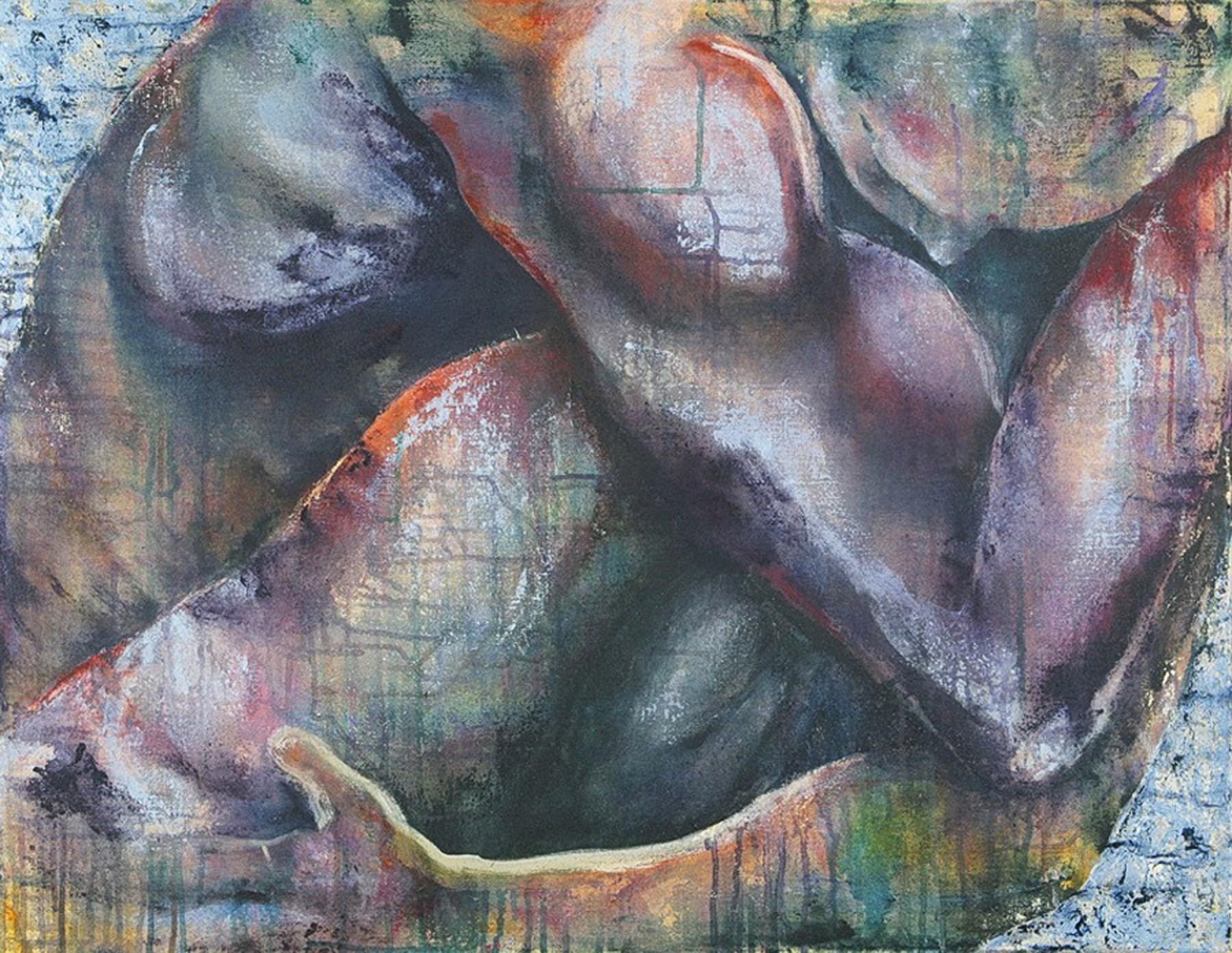
56
Ellen Freyer
Becoming a Woman: Adult. Archival print. 20 x 16 inches. 2011
Becoming a woman means internalizing society’s expectations of the feminine, remaining bound literally and psychologically from childhood to adulthood.

57
Sara Friedlander
Chinese Women: Bound and Determined #1. Mixed media. 11.25 x 31 inches. 2001-12
These Chinese women, whom I’d photographed in 1983, many with bound feet, inspired my first mixed media series, Chinese Women: Bound and Determined. The secret nature and pathos of their unique suffering, and the dignity with which these women carried their plight, moved me deeply. I wanted others to see them as I had. In order to highlight their humanity, I painted onto and around the photographs, enhancing the atmosphere surrounding and supporting each woman.

58
Chiara Galimberti
I wanted to speak to the idea of social divisions between authority and rebellious forces, and specifically address the dynamics of how power is maintained and relinquished. I wanted to investigate how we are bound to our social position, and how there is both a struggle to break down those boundaries and the systematic investment in maintaining them that benefits the powerful, and disenfranchises people at the margins of power.
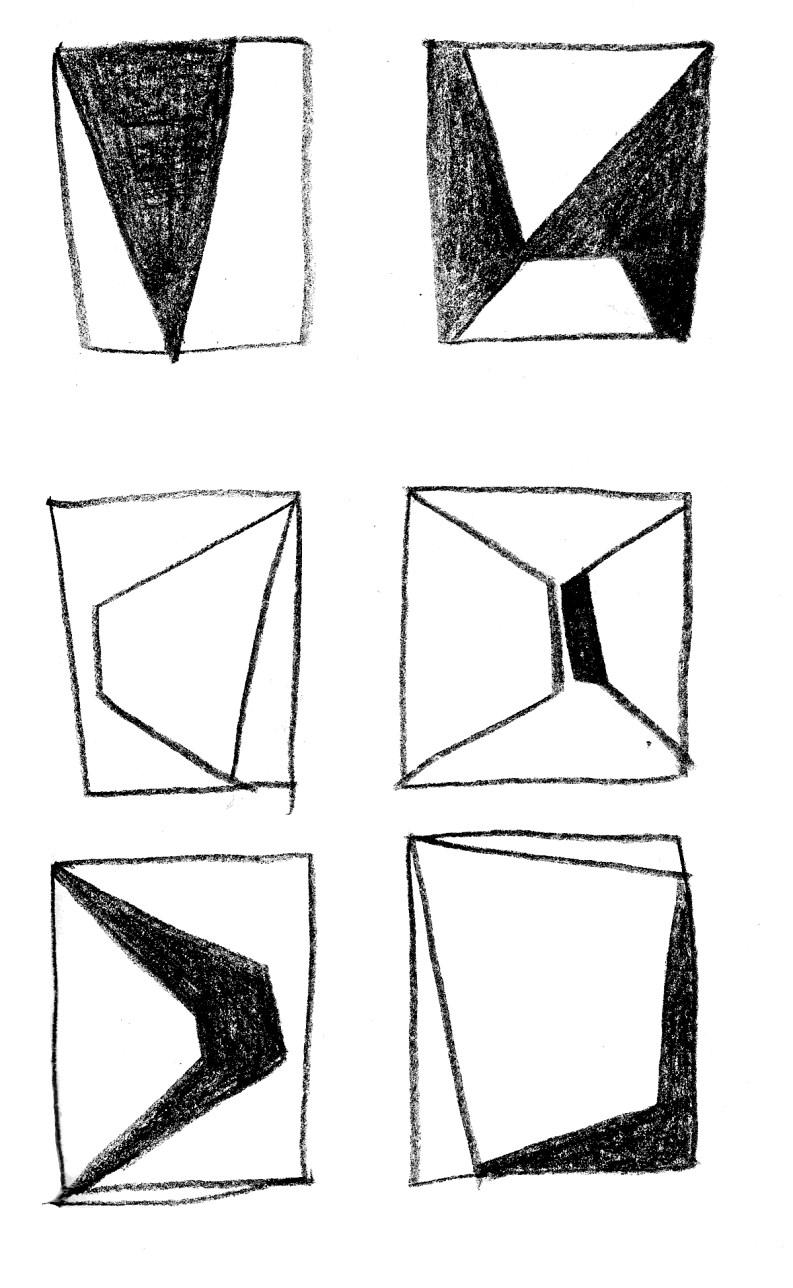 Cops and Robbers. Paper. 52 x 32 inches. 2012
Cops and Robbers. Paper. 52 x 32 inches. 2012
59
Margaret ‘Margo’ Garces
Rediscovering my artistic voice after a 25 year sabbatical has been integral to this work. This photograph shows the post struggling to do its job but tiring throughout the years, the post stays in place as it is bound to its farmer. This watercolor shows the parallels of our lives as we endure being bound to our own struggles, responsibilities and employer. Whether we are bound physically or mentally in our lives, the only way out is escape!
 Captive. Digital photograph inkjet print on glossy paper. 22.75 x 18.75 inches. 2011
Captive. Digital photograph inkjet print on glossy paper. 22.75 x 18.75 inches. 2011
60
Knotted Wing. Felted wool and silk fiber. 60 x 25 x 10 inches. 2012
Knotted Wing was originally inspired by the idea of ambition bound by limitation. The weightless symbol of the wing, made from flossy wool, is knotted. Can it fly? Perhaps its secret lies in the transition of wool manipulations, as raw wool transforms into felted wing—a testament to evolution, growth and transformation. Intended as a secular work, I embrace tangential concepts such as mortality & religion that are drawn in by the cultural symbolism of the wing.
 Jenne Giles
Jenne Giles
61
Marguerite Gilligan
Bound by Reason is an ongoing exploration, both personal and objective, that relates to the multifaceted nature of the used book; its material quality, its state of being, its smell, its aging process, its subject matter, and the memory that it holds (as reflected in its ephemeral quality). The book perpetuates my conflict with western knowledge and how it has bound us to war, orthodoxy and prejudice. My impulse, when faced with such an object, is to render it harmless.
 Swanns Way. Glass and paper. 12 x 7 x 7 inches. 2012
Swanns Way. Glass and paper. 12 x 7 x 7 inches. 2012
62
Laine Godsey
My work engages in notions of familiarity and obscurity, including vulnerability, protection, and the contentious relationship of our bodies and the spaces to which they are bound. Social dynamics of the family, dwelling and the obtuse and abstract sense of being are all important topics within my research. Considering the ties that bind us to perceptual space, I am stirred to express a fluid relationship between the symbolic and the concrete—the conceived sense of place and the physicality of location.
 Family Portrait. Digital c-print. 20 x 24 inches. 2012
Family Portrait. Digital c-print. 20 x 24 inches. 2012
63
Janice Gossman
Respect My Boundaries. Mixed-media: plastic, plaster, glue, and paint. 13 x 13 x 13 inches. 2012
A question of boundaries arose through a relationship with a very good friend. I have tried to find a visual expression for the feeling of having one’s personal boundaries crossed. In Respect My Boundaries the orb is being bitten all over by sets of fangs. Other sets of fangs on its surface face outward, conveying the orb’s intention to bite others who might further provoke it. The viewer is encouraged to reflect on her/his own set of personal boundaries, while also considering what materials the sculpture is made of.

64
Guerrilla Gowns
Guerrilla Gowns Revealing Symbolic Hidden Items from the Inside of Gowns. The performance is an organic unfolding experience for both viewer and performer. Variable. 2012*
We are Guerrilla Gowns, a group founded in the roots of relational art utilizing the elements of surprise performances in order to engage an audience and expand the discussion of feminine power with a contemporary approach emphasizing a quieter aesthetic. In this performance, in which artists are clothed in bridal gowns, we create a metaphoric event. This symbolizes a woman’s ability to dream and to manifest dreams, transforming our pasts, presents and futures by tapping into a liminal state between thought and action. Guerrilla Gowns Revealing Symbolic Hidden Items from the Inside of Gowns.

65
Kath Greco
We are bound by our own limitations but we also create imposed boundaries. Cocoon represents our self imposed boundary for comfort and protection. I collect bark pieces, preserve them and use them in my art. Tree bark acts as the host to surface plants like lichen and moss. These plant forms represent my mom’s untreatable cancer. She lives with the marks of the cancer but she is protected externally and surrounded by love, symbolized by the crochet cocoon.
 Cocoon. Vinyl Jelly Yarn, tree bark, cotton canvas. 8 x 10 inches. 2012
Cocoon. Vinyl Jelly Yarn, tree bark, cotton canvas. 8 x 10 inches. 2012
66
Karen M. Gutfreund
NEVER ENOUGH. Mixed media on board. 24 x 24 inches. 2012*
My CRTL-ALT-DEL series examines the concept of creating ‘do-overs’, juxtaposing the digital realm manifesting in the personal—in one swift keystroke, wipe everything out to reinvent oneself and start again. NEVER ENOUGH speaks to addictions, desires and obsessions that take over, creating consequences that cannot be undone. Current consumer culture is focused on amassing possessions and instant gratification, creating needs that are never satiated. No amount is ever enough.

67
Kelly Hammargren
Tree Ladder and Me. Digital photograph on 100% bright white cotton rag with archival inks. 21.5 x 26.5 inches. 2012
I stopped, entranced by the tire-swing that hung from a single rope. Just a few feet further was the ladder. I hungered for the days when I was free from my adult constraints, and could nestle in the trees and listen to the rustle of the leaves. I moved on and there, in the midst of rows of trees, was a young woman lying under the trees—barely visible except for her black stockings. I took in the air and sun, longing for the days before time stole my love from me, bound with the absence and released with the richness of my memories.

68
Teresa Harris
Finder. Mixed media, wood, paper, transfer, ink, mixed media, wax, brass. 8.75 x 8.75 inches. 2010
Finder embraces the many layers, roles and trials of womanhood. Her life is defined by her relationships; she is both bound and freed by them.

69
Martha Markline Hopkins
My latest work consists of shaped acrylic canvases stretched over various objects, exuding a hidden mystery. Something is definitely there, but is not actually visible. It is left to the viewer to decide what emotions the objects evoke. Certainly, the notions of being ‘bound’ or ‘controlled’ are expressed. The canvases are painted in a minimal way, yet provide expression.
 Corinthian White. Acrylic on shaped canvas. 24 x 24 x 3 inches. 2012*
Corinthian White. Acrylic on shaped canvas. 24 x 24 x 3 inches. 2012*
70
Bound X 2. Bronze, clay and steel. 17 x 8.5 x 8.5 inches. 2011*
Bound X 2 was first created as a single bronze piece, titled ‘Bound’. It was created by wrapping one shape over another, identical shape, in order to bind them together. To further this effect I created a clay version, mounted them end-to-end and elevated them over a steel base.

Jan Hoy
71
Tehniyet Hussain
Behind the Doors - Marital Rape. Mixed media. 26 x 18 x 6 inches. 2010
My work focuses on social injustices specifically inflicted upon women, all over the globe. Historically, women have endured violence without uttering a word of discontent. Even today, most of the societies are bound by archaic patriarchal traditions. Rape within marriage is one of the most prevalent, yet the most under-reported, form of violence against women. This crime is committed within the secured boundaries of home, not only harming the victim physically, but leaving her without honor or dignity.

72
Bara Jichova
Boundaries occur in the “box” of monogamous marriage, and are supplanted by a new triangular boundary. Adultery brings excitement and the illusion of freedom, even as new boundaries are created: the external boundaries of an affair’s physical space, and the internal boundaries of falling in love to avoid the pain. In longing for a life beyond the ordinary, hoping to gain the lost and to love through the other, the lovers find themselves in even smaller box of restrictions, with the same lack of freedom, hurting each other.
 Adultery 3. Hand made collage, photographs. 16 x 20 inches. 2012
Adultery 3. Hand made collage, photographs. 16 x 20 inches. 2012
73
Joy Johnson
Ties That Bind - The Sisterhood. Wood and mixed media. 27 x 7 x 6 inches. 20111
Ties That Bind-The Sisterhood symbolizes the strength a woman gathers from the love and support of the sisterhood.

74
Robin M Jordan
I am bound by my aging body, as my future and past grow closer together. Unlike the human body, steel through patination—becomes more beautiful as it ages. Words also change over time as language develops. The dichotomy of the perceived toughness of the steel and the ephemerality of language is at the core of my word sculptures. MakeMe is a simple, strong command. This sculpted command is compressed, pushed together as if outside forces have attempted to bind the words, and the viewer is a witness to their survival.
 MakeMe. Steel. 17 x 16.25 inches. 2011
MakeMe. Steel. 17 x 16.25 inches. 2011
75
Joanna Kidd
Letters. Video. 2 minutes. 2012
My most recent work deals with perception and interpersonal communication. The goal is to create visual representations of inner emotional states with work that provokes an immediate emotional response. I am interested in the limits created by verbal communication, and the way that we become bound and reduced to the words that we use to describe ourselves and each other.

76
Jappie King Black
This is one of a series of small pieces that are wall mounted. As a group they become a single narrative with references to nature, the figure and ritual.
 Bound Falling Figure. Grapevine bark. 12 x 4 x 2 inches. 2012
Bound Falling Figure. Grapevine bark. 12 x 4 x 2 inches. 2012
77
Judith Kornett
We are all bound by circumstances, our personal history, and the demands of those around us. This often results in feelings of helplessness, depression, and anger. Sometimes these feelings drive us forward, for better or worse, into places that could not have been anticipated or otherwise survived.
 Bully For You. Wood fired ceramic, wall hung. 18 x 20 x 8 inches. 2010
Bully For You. Wood fired ceramic, wall hung. 18 x 20 x 8 inches. 2010
78
Bernice Sokol Kramer
Strumpelsack. Paper Mache, newspaper over recycled clothing. 63 x 28 x 19 inches. 2011
My destiny is bound to the space I live in. I am bound or limited by clothing, but alternately free to create my own shape or figure in the world. I can escape or live in my space. Am I a woman/shell hybrid—a modern version of Botticelli’s “Birth of Venus”? I wrap myself for protection, like an animal in a shell. Have I already left my home, or have I created a refuge for future habitation? I am either Earth or heavenbound.

79
Diana Krevsky
Liberty, constitutional rights, and freedom of speech held hostage, bound by US Patriot Act laws enacted under a pretext of national security.
 Hostage. Graphite and acrylic on paper. 21 x 21 inches. 2004
Hostage. Graphite and acrylic on paper. 21 x 21 inches. 2004
80
Linda Kunik
No
Each of us has a unique background. We come from a particular place in the world, have a certain set of parents, went to different schools and grew up with a specific history. All of these create the person we are: our strengths, our weaknesses, our foibles. These are the roots which bind us. How do we leave them behind, even if they’re golden? Are we capable of leaving them behind, moving beyond them to create our own future and persona? This assemblage addresses that question.
 Escape. Root, gold wire, wooden frame. 20 x 24 x 10 inches. 2012
Escape. Root, gold wire, wooden frame. 20 x 24 x 10 inches. 2012
81
Kristin Kyono
Escape. Acrylic on panel. 36 x 36 inches. 2012*
Some boundaries are self-imposed. What might these walls provide? In my art, I meditate on the beauty of urban environments. I look for underlying relationships, real or imagined, among the forms I see everyday. The juxtaposition of organic and engineered shapes inspires me.

82
Release. Polyester fabric. Variable. 2012
Release is an expression of releasing the pain of generational sexual and physical abuse of women in my family.
 Olga Lah
Olga Lah
83
Beth Lakamp
Hospital Bed. Oil on canvas. 24 x 24 inches. 2012
Personal space, defined by the lines of our circumstances.

84
Elizabeth Larrabee
Bound from years of commitments and care giving Denial of creative expression and self-limiting thoughts I break free of my own boundaries

Dripping, spattering, scraping, scrubbing
To discover what lies beneath the surface and beyond the edge
Unraveling Corset. Enamel on roofing felt. 35 x 40 x 2.5 inches. 2012
85
Laurel Lee
Berkeley Hills. Ink on paper. 12 x 18 inches. 2011
I am a visual artist who came out as a lesbian in her early thirties. I can truly say my work is always done with eyes toward social health, but I never lose the desire to also create fine art. Visual statements are a reflection of the artist, and artists are categorized—sometimes to the detriment of their complexities. Categorization sometimes works to prevent serious consideration of the Other.

86
Laurel Lee
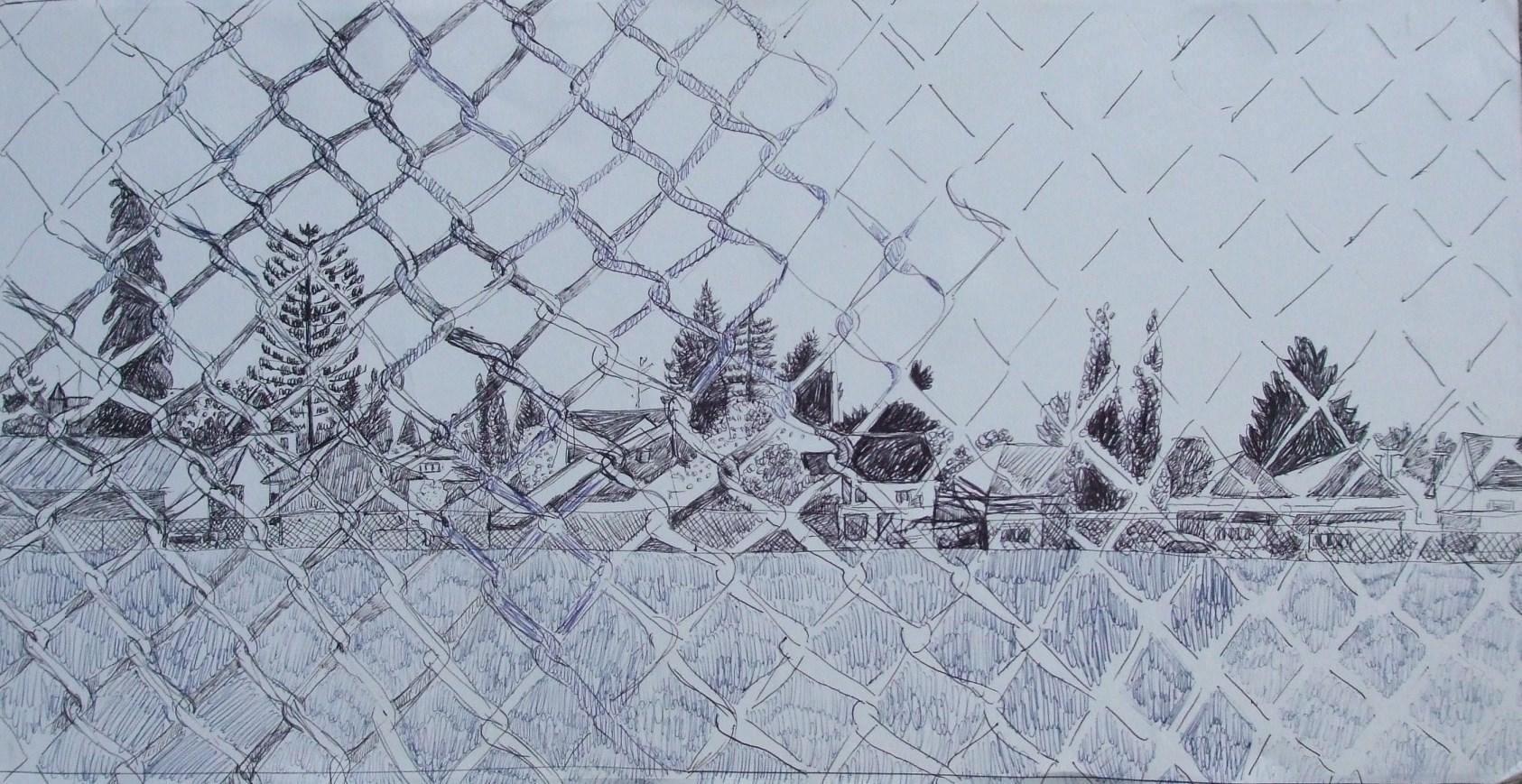
87
Woven Fence. Ink on paper. 10.5 x 20 inches. 2011
Linda Levinson
Country Gardens. Archival inkjet print. 17.5 x 20.5 inches. 2012
Country Gardens is from a series of images derived from discarded, bound photo albums. The punch holes are vestiges of the original binding. The photo corners themselves once bound vernacular photographs, subsequently liberated. From the texts, we know the subjects included bound terrain (gardens) and temporal bindings (after). The series focuses on the optical and conceptual vibrations of open and bound spaces.
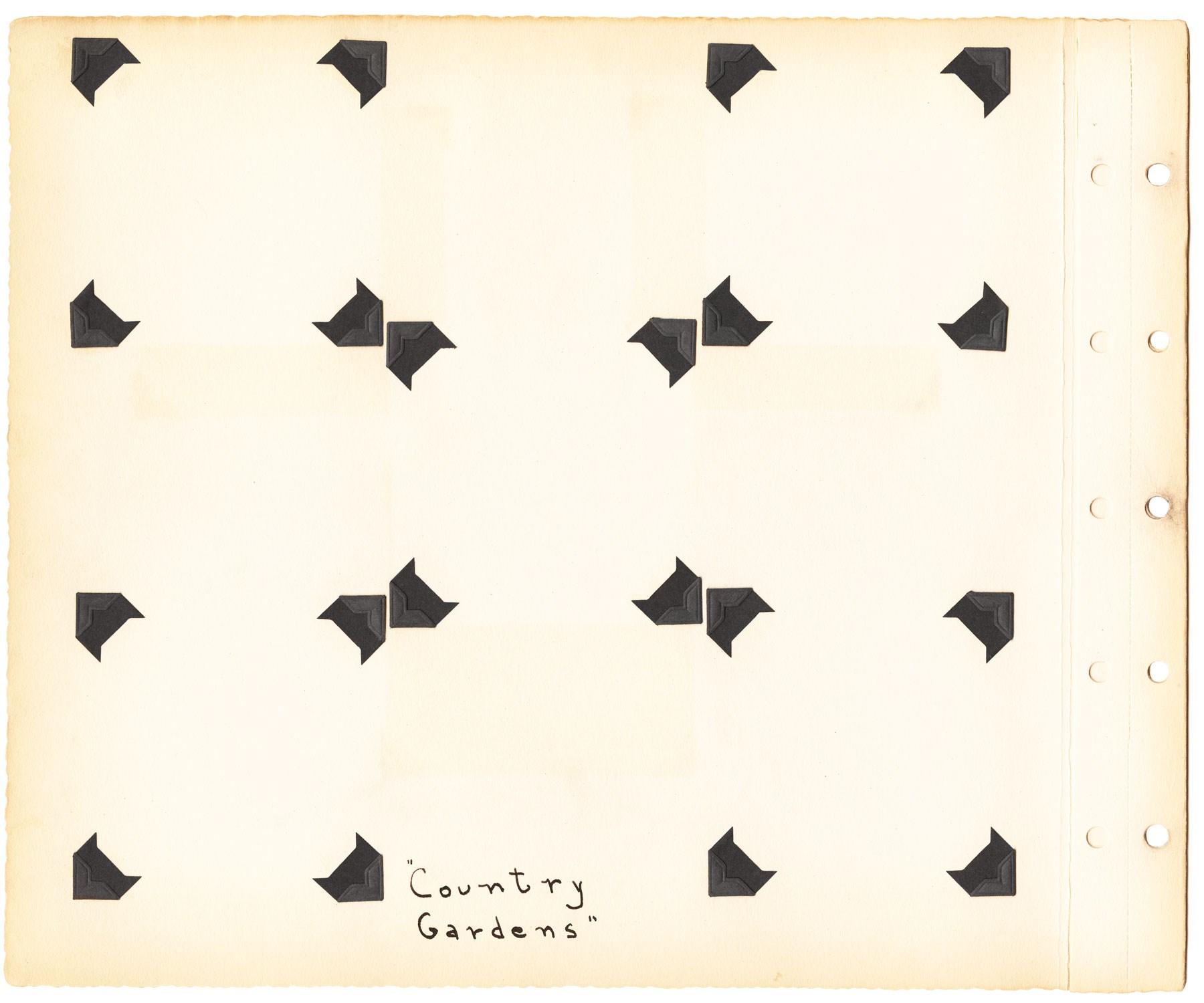
88
Elizabeth Lind
Ondine. Vermont marble. 14 x 11 x 9 inches. 2004
Ondine depicts multiple images of women, patently luring the viewer, but in fact strong, centered, and enduring. A portrait looks out imprisoned yet not seeking rescue. The work depicts women and their environments.
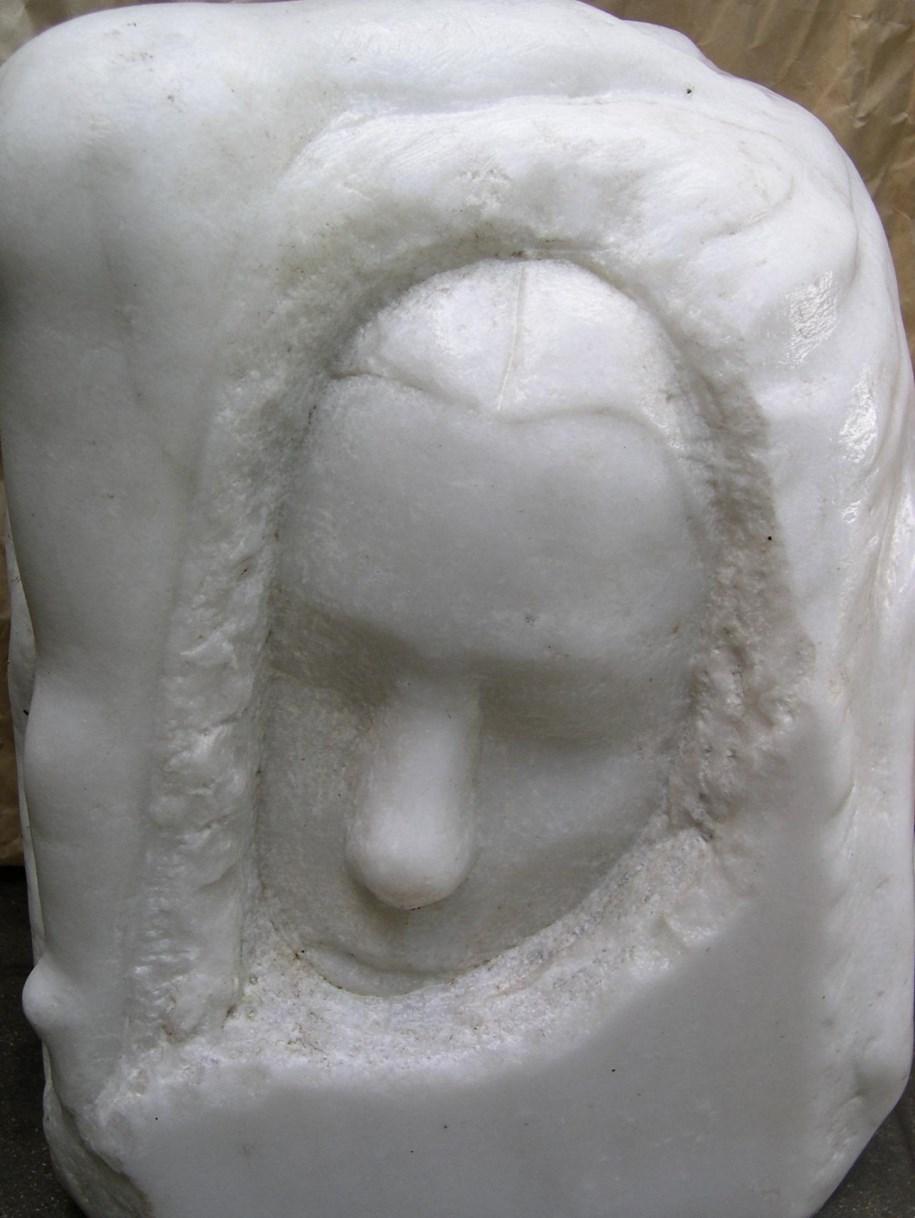
89
Harriet Livathinos
My personal studies in abstract drawing involve employing graphite, conte, pastels, and ink on a variety of surfaces, concentrating on the raw energy of line to serve expressive purposes. Two conflicting interpretations of “Bound”, for me, include the restrictive frustration and panic of physical or psychic restraint, as opposed to the more positive ties that bind loving relationships. My work reflects both interpretations.
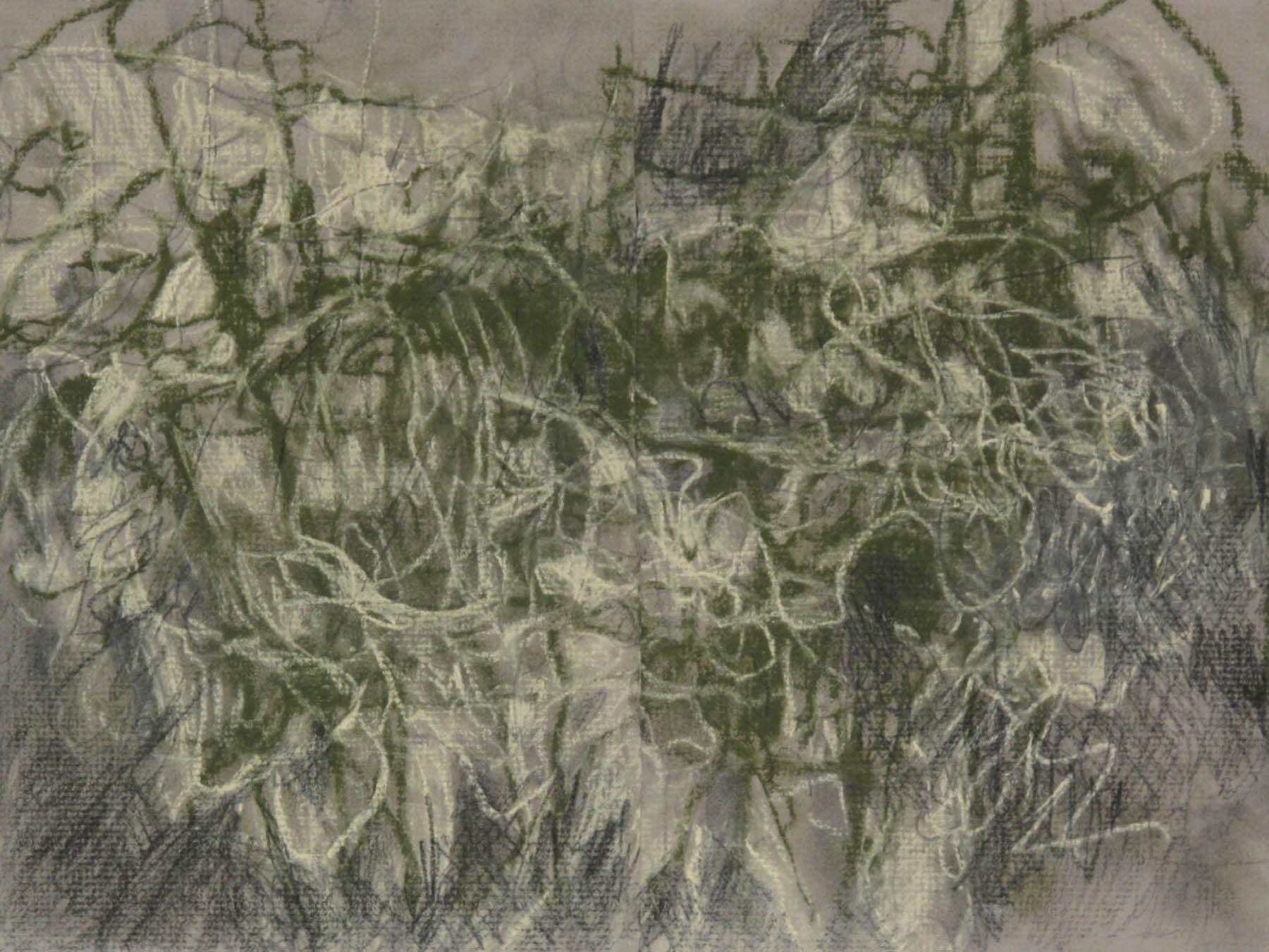 No Escape. Pastels on paper. 17 x 21 x 2 inches. 2009
No Escape. Pastels on paper. 17 x 21 x 2 inches. 2009
90
Aline Lotter
My model, Sabrin, is a young immigrant/refugee from Sudan. She escaped her bonds in Sudan, and now struggles to find happiness in this strange new land. She has donned her native dress to please we artists, and make a few bucks. All we can do is show her pain, her strength, and her hope.
 Portrait of Sabrin. Paper. 17 x 11 inches. 2012
Portrait of Sabrin. Paper. 17 x 11 inches. 2012
91
Sarah Lubin
This work brings attention to details of life that may not seem realistic, but are still familiar. A mostly ordinary scene is turned into something stranger and more fantastical—in the same way memory can function. The interlocking of figures and narrative in the composition leaves an airlessness to the atmosphere that can give the figures a static, and even suffocated quality at times. The figures are bound both in the narrative and in how they are positioned, but there is nonetheless a latent, albeit restrained, energy.
 Coffee Table. Oil on canvas. 20 x 16 x 2 inches. 2012
Coffee Table. Oil on canvas. 20 x 16 x 2 inches. 2012
92
Virginia Maksymowicz
Life-casting is central to the imagery and process of my sculpture. Taking a mold from a living being and producing a positive cast in plaster challenges perception. There is something compelling about such imagery: think of Lot’s wife turning into a pillar of salt, or Pompeiians becoming bound in ash—only to have their forms unbound centuries later in plaster. In Bound, two human arms, lifelike in detail but stifled by stark whiteness, break the rope encircling their wrists but remain constrained by their materiality.
 Bound. Hydrostone. 17 x 12 x 4 inches. 2012
Bound. Hydrostone. 17 x 12 x 4 inches. 2012
93
Karlene McConnell
Past Limitations. Acrylic on canvas. 22 x 28 inches. 2012
In my recent landscapes, man-made structures have appeared. Fences and gates are prominent among these structures. In some cases the fences are painted in and then obliterated—almost as if they are fading away into the distance, or being broken down to let the viewer in to explore new ground. They serve as metaphors for the inhibitions of the past, and portals to the future.

94
Kelsey McDonnell
This piece speaks to being broken, both in the literal sense and metaphorical sense. We form our identities as we grow; who we are, or who we believe ourselves to be, is connected to our home, our childhood and how we grew up. One can certainly break away from the past, forgive, and move on, but we are all bound to our past. Good or bad, our past has carried us to the present moment and we are bound to its existence.
 Broken Home. Acrylic on canvas. 22 x 28 inches. 2012
Broken Home. Acrylic on canvas. 22 x 28 inches. 2012
95
Allison McElroy
It will be Again. Clay board, graphite, coffee stains, micro slides. 11 x 17 x 2 inches. 2012
Veil: a piece of transparent material worn to cover, conceal, shield, screen, and protect.

96
Elizabeth Mesa-Gaido
In January 2011, I traveled to Cuba for the first time, to visit the country where my parents were born. The work is based on the sea of consumer goods & pharmaceuticals carried in to Cuba by exiles to assist those who have no access to necessary, daily items like medicines and commodities. While there is no way of tracking the actual amount spent on items, foreign remittances (money sent to Cuba by exiles) are estimated at $1 billion a year. Cuban-Americans and Cubans remain bound to one another—socially and financially.
 Then & Now I. Mixed media. 10 x 20 inches. 2012
Then & Now I. Mixed media. 10 x 20 inches. 2012
97
Beverly Mills
We are bound by secrets—secrets that seem so terrible, and so shameful. They were born in the very places meant to keep us safe. These secrets poison our sanctuaries and create our nightmares. Who is keeping these secrets? Speak out; break the bonds.
 Haunted Sanctuaries #3. Black and white collage. 24 x 18 inches. 2012*
Haunted Sanctuaries #3. Black and white collage. 24 x 18 inches. 2012*
98
Jennifer Mondfrans
From a series of paintings I did based on the photographs by Brassai of Parisian prostitutes. It is a profession that a woman does not choose, but is bound into doing to live; it would not be around if men didn’t need it. Sex is part of our biology, but payment makes it illegal, and it becomes a part of the endless cycle of women asking and men taking. Why are the women bound to be punished, when they offer what is needed?
 No. Oil on board. 16 x 12 inches. 2011
No. Oil on board. 16 x 12 inches. 2011
99
Patty Neal
Somewhere Over Brooklyn. Oil on hardboard. 28 x 16 inches. 2012*
The focus of my work for about 20 years has been the exploration of visual, mental and emotional boundaries. My process is often literally about boundaries. I make a piece by putting together multiple panels, or I segment a single panel into separate visual spaces. Often the things I paint are literal boundaries: walls, fences expanses of water, highway median strips, etc. My intent is to invite viewers to look beyond these boundaries to see the possibilities of a connected whole.

100
Tae Nelson
My paintings are defined by action. The spontaneity and energy of my painting style is important to the work. Marks are gouged, scraped, drawn, spattered, and dripped. The painting wraps around the edge of the panels allowing the piece to be expansive and unbound. I become totally immersed in the process, which is both wild and deliberate. It is a lot like my life.
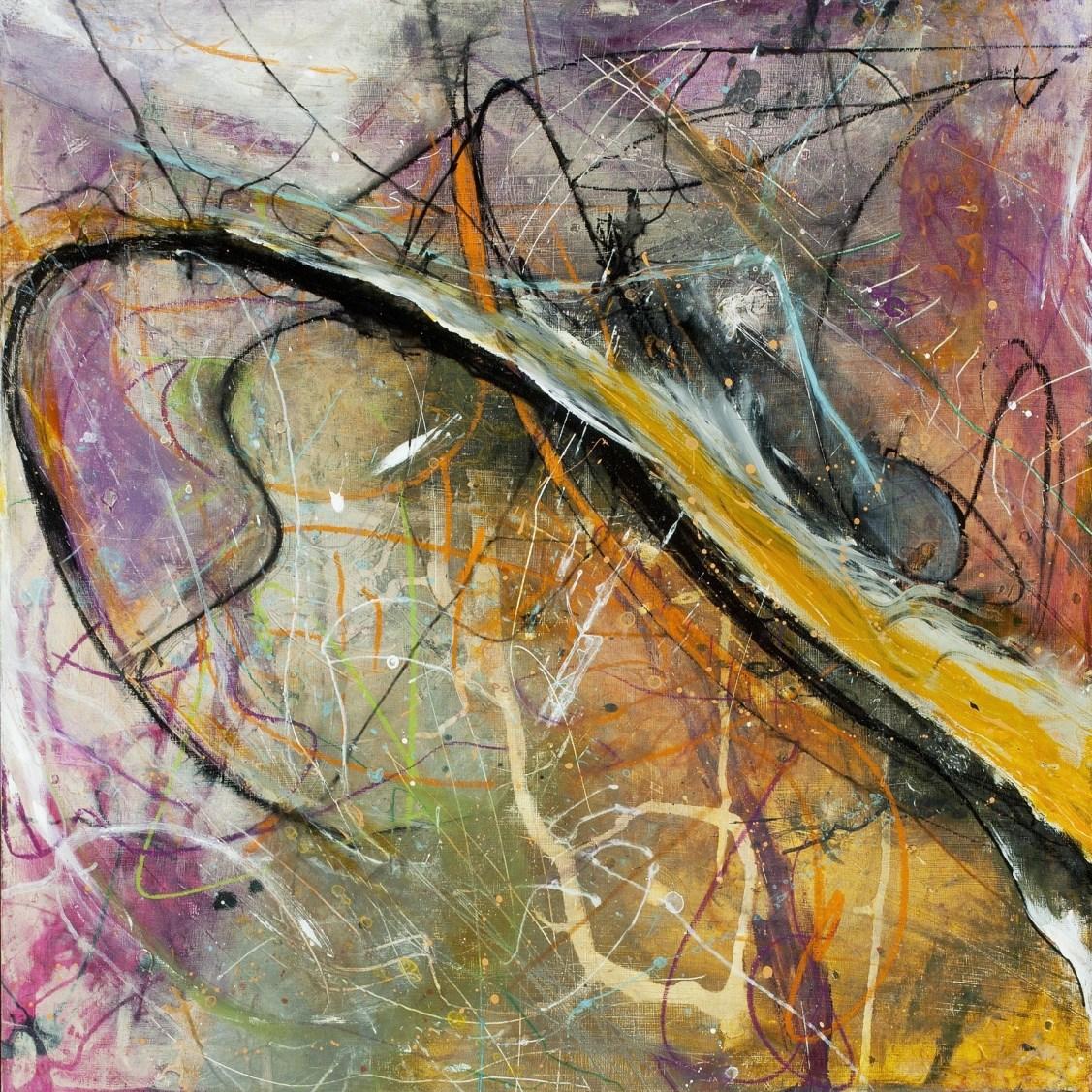 A.E.B. 47. Acrylic on wood panel. 30 x 30 x 2 inches. 2012
A.E.B. 47. Acrylic on wood panel. 30 x 30 x 2 inches. 2012
101
Jean Nerenberg
Celestial Navigations #1. Watercolor mounted on wood cradle. 14 x 18 inches. 2008
Celestial navigations are part of a series that explored man’s relationship to the universe. We are bound to earth but look up in awe at the stars and planets.

102
Martha Nicholson
Notebook Pieces: Constraint. Oil on paper. 24 x 24 inches. 2011
These drawings spit restlessness the underbelly of constraint. Bound. Agitated. Gritty. Abrasive. These images are bound taut and tight within the rectangle. Some push fierce and hard against the boundary, others dart and flail. Some are chaotic and writhe, syncopated and staccato, snared by four edges— structural battles—forms that encounter and skirmish wrestle for balance. Some harsh, some fluid. Some lure with provocative texture: Black oil laid down with true intention and clear voice.

103
Being ‘Bound’ socially and economically can set up psychological limitations. In Closed Door the duality of being bound and that of psychological freedom are represented by juxtaposed and contrasting areas of pale pink and black pigment. Color choice was based upon stereotypical representations of women.
 Peggy Nino
Closed Door. Oil on paper. 22 x 30 inches. 2012
Peggy Nino
Closed Door. Oil on paper. 22 x 30 inches. 2012
104
Michele Noiset
My work represents a dystopian doctrine, and the ways in which humans place constraints and limitations on one another. All societies begin with a utopian ideal of a perfectly constructed world. Weaknesses in human nature slowly undermine these ideals. Hierarchies are created. Power is abused. One group gains control over another. Those without power are forced into submission. In my layered pastels, I use monochromatic tones to pare down my concepts to their simplest and most direct form.
 Censored. Pastel. 18 x 24 inches. 2012
Censored. Pastel. 18 x 24 inches. 2012
105
Tanya Nolan
To be bound is a human condition; we are bound to the earth by physical means and to each other through psychological means. We see beauty when these ties are seemingly transcended, and we also see our own vulnerability. Through language and a physical artistic process, this piece explores what it means to be bound and the inherent human desire to be free.
 Release Me. Ink and crayon on Vellum. 36 x 36 inches. 2010
Release Me. Ink and crayon on Vellum. 36 x 36 inches. 2010
106
Taryn O’Reilly
My three dimensional series, Yellow, was inspired by Charlotte Perkins Gilman’s “The Yellow Wallpaper”. Each box contains a figure that is both provocative and vulnerable in pose. While they appear to be declaring their sexuality, the figures are trapped and covered amongst their own ‘pretty prisons’. I wanted the piece to center around the idea of boundaries and why they exist. Often times we create inner barriers through our own expectations, and sometimes it is what is expected of us that binds us.
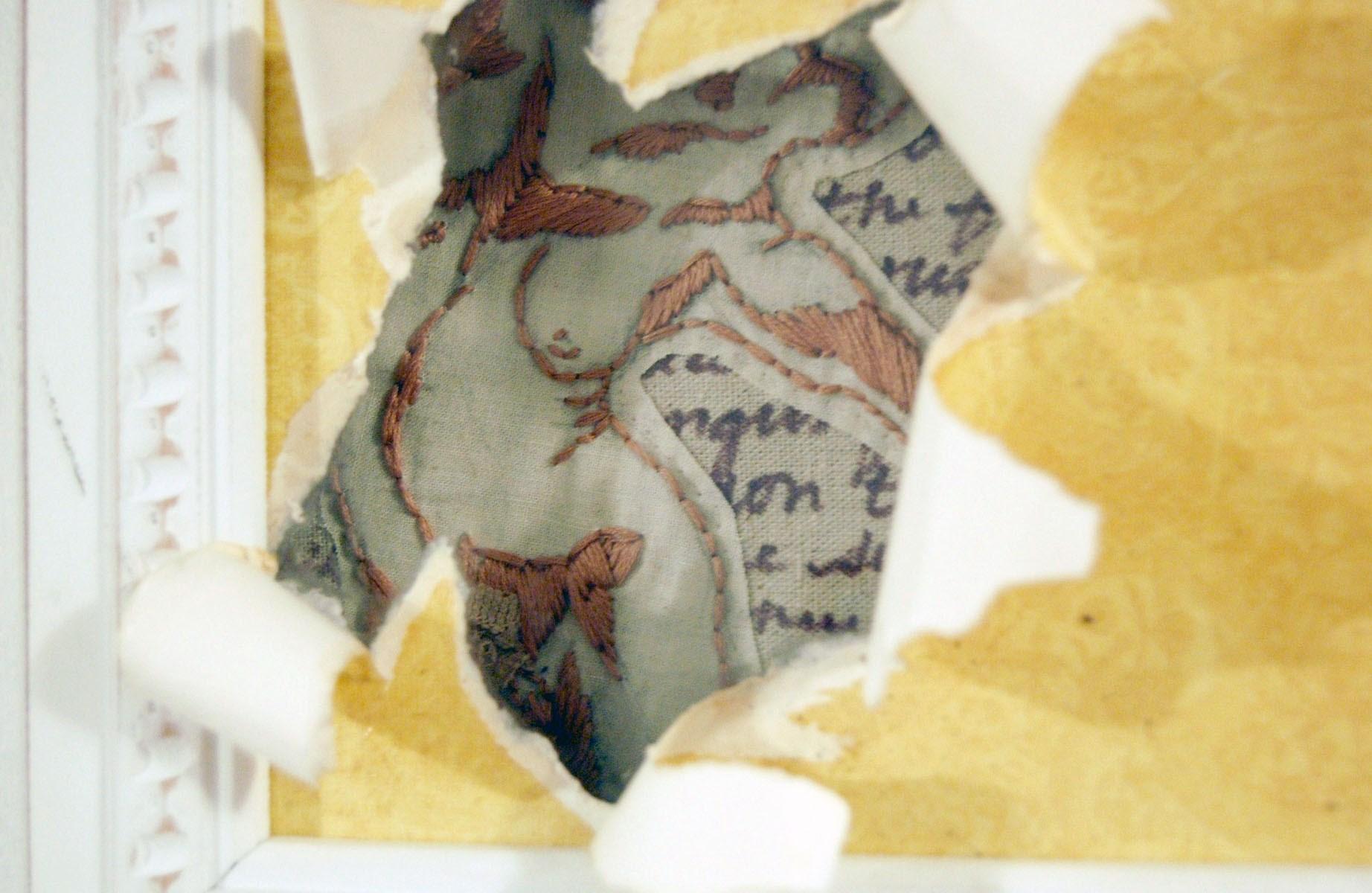 Yellow. Wood, fabric, glass, fabric pen, and thread. 10 x 12 x 3 inches. 2012
Yellow. Wood, fabric, glass, fabric pen, and thread. 10 x 12 x 3 inches. 2012
107
Mervi Pakaste
Till Death Do Us Part. Letterpress on paper. 9.5 x 10 inches. 2012
Till Death Do Us Part was created to draw attention to domestic violence. The victim often feels helpless and bound to their abuser, unable to see a way out.

108
Bhanu Palam
Storytelling on canvas, using my fascination with spirituality and nature’s four elements air, water, fire and earth—are my primary objective. Combining them with my emotions through paint is what I am deeply passionate about. Another desire is to create works of art that will have a great impact on one’s eyes and soul. I want to contribute my art to the world with a hope to convey a difference in our societies.
 Dual Vision. Oil on canvas. 16 x 20 inches. 2011
Dual Vision. Oil on canvas. 16 x 20 inches. 2011
109
Margaret Parker
a Mer I cans, 16 panels. Wood, deconstructed cotton T-shirts. 40 x 40 inches. 2012
This group of pieces explores the layers of identity that are bound up in being ‘American’. It demonstrates that different behavior patterns of weaving, tying, or knotting carry different meanings. It shows that how strands are bound together or torn apart makes new families. Being a Mer I cans means giving up the old skin of tribes, races, and nationalities, to create your own meaning and write your own sentence out of that one word.
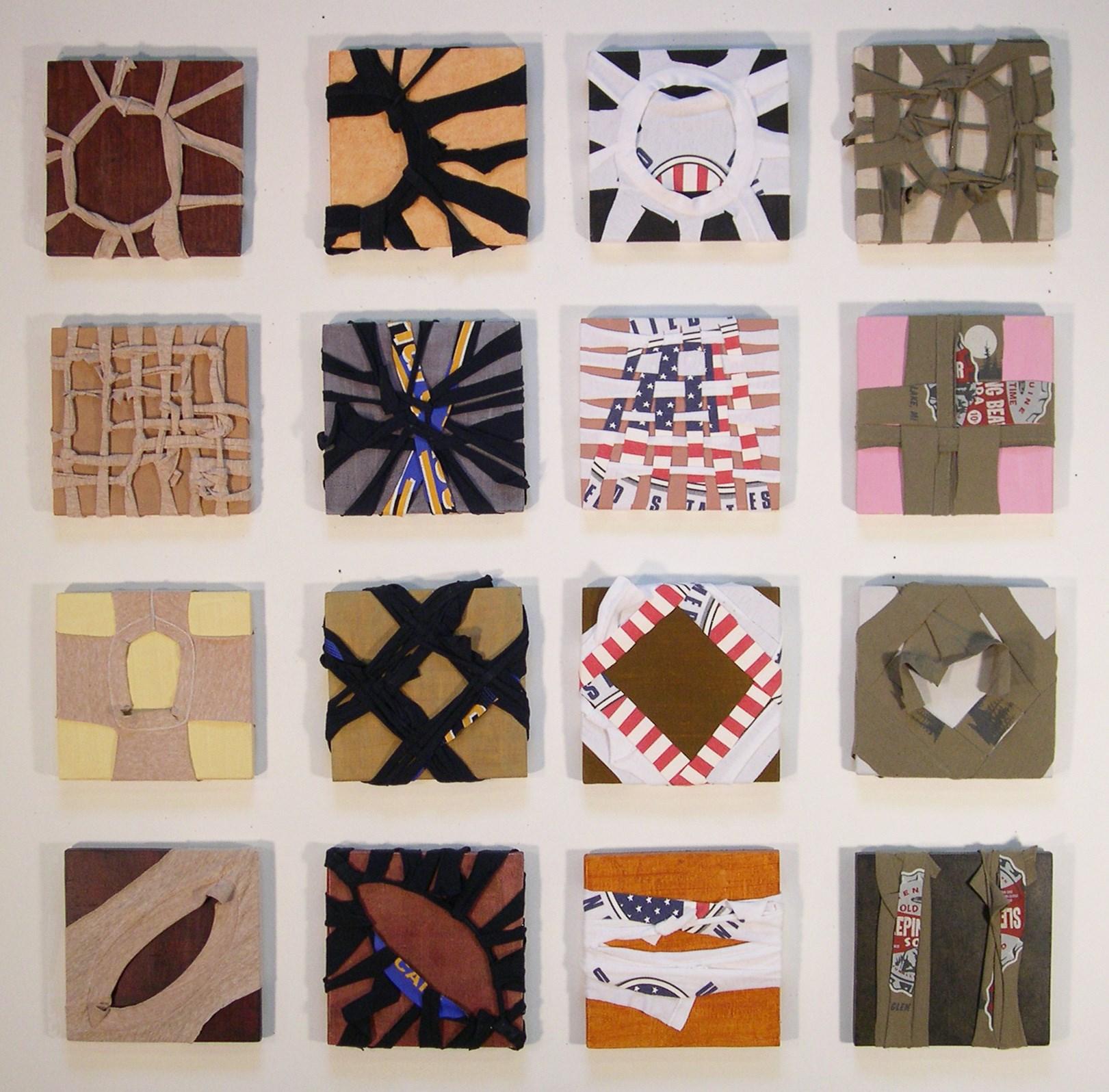
110
Kate Paul
Innocence. Acrylic, oil, silver leaf, cut-out on foam board and canvas. 20 x 28 inches. 2012
Innocence represents the confines of being bound by the threat of compromise and corruption to the innocent.

111
Nancy Peach
I became interested in Kinbaku, a form of the art of Japanese bondage (Shibari). Kinbaku means tight binding, using simple yet visually intricate patterns. Japanese bondage is very much about the way the ropes are applied and the pleasure is more in the journey than the destination. ‘Ruinous Means’ exhibits the extreme tight binding, practiced by a Nawashi (rope master).
 Ruinous Means. Pencil on vellum. 20 x 16 inches. 2012
Ruinous Means. Pencil on vellum. 20 x 16 inches. 2012
112
Diane Pepe
My sculptures explore the juxtaposition of structured wood and brass elements as they contain and bind the organic qualities of the rocks. Initially this interaction attempted to describe the nature of people I met while in Kochi, Japan. This concept transformed into a more universal investigation of formal elements in our society that order and bind our passionate and energetic spirit. In the collages the soft drawn colors and shapes represent our emotions; the hard cut paper units signify order that contains and bind our passions.
 Column III. White poplar, white marble stones, brass rods. 15 x 4.5 x 5.5 inches. 2011*
Column III. White poplar, white marble stones, brass rods. 15 x 4.5 x 5.5 inches. 2011*
113
Jane Peterman
Over the course of a long marriage, I have had cause to think of divorce many times. I was thinking about the pending divorce of two friends while working on this small painting. We are bound in marriage by simple and complex things, mealtime rituals or money. We can divorce, but we are still bound by the life spent together.
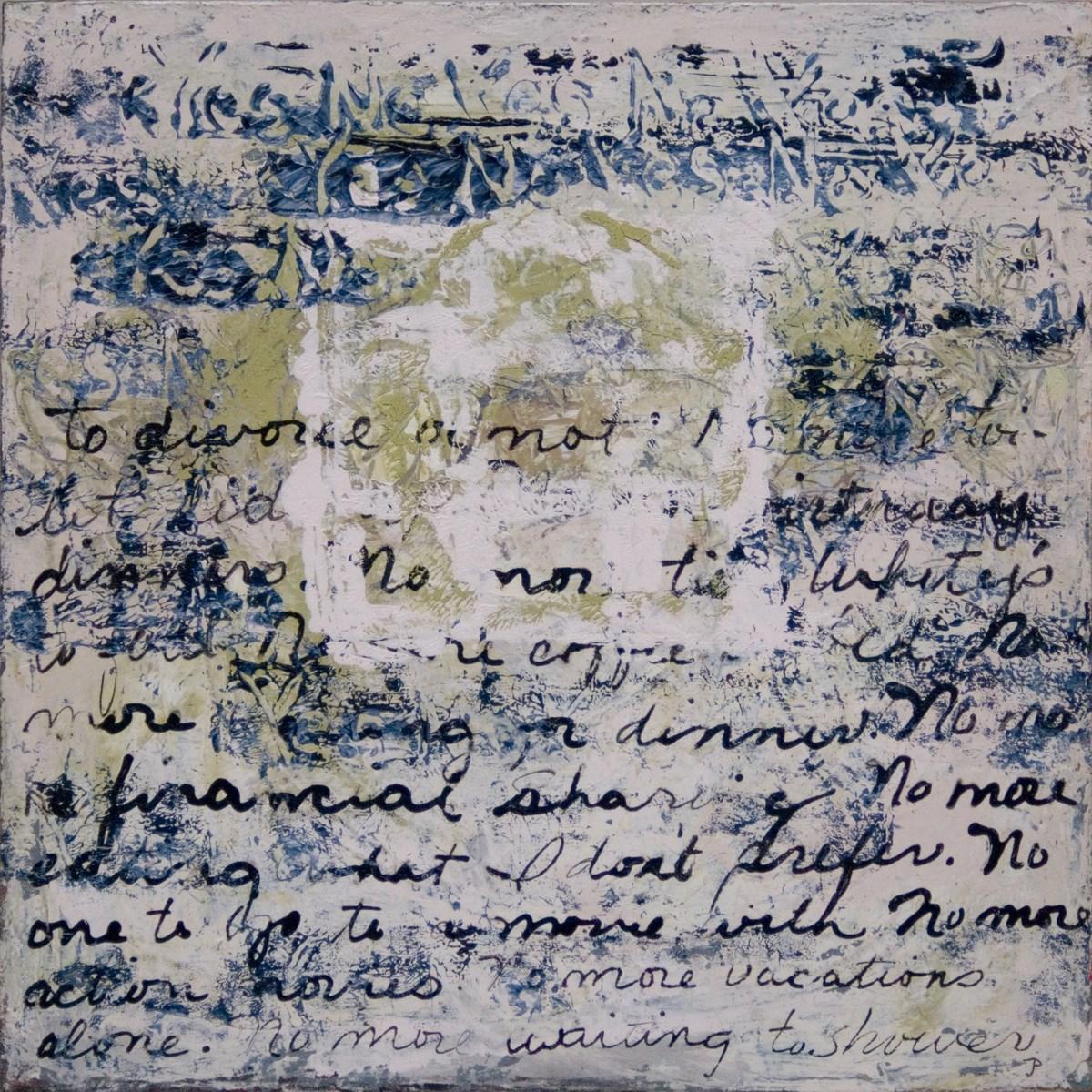 To Divorce or Not. Acrylic on canvas. 24 x 24 inches. 2012*
To Divorce or Not. Acrylic on canvas. 24 x 24 inches. 2012*
114
Laura Petrovich-Cheney
Rachel Carson wrote: “I have felt bound by a solemn obligation to do what I could. If I didn’t try I could never be happy again in nature.” Like her, I am bound to care for the earth before it is irretrievably gone. This obligation forces me give value to what is ignored, stepped on or washed up as debris. Things that are in a state of transition are the most intriguing. In this ephemeral state, its interior life is vulnerable. I collect these things to preserve them—to hold on to its former self and prevent it demise.
 Good Bye Clancy. Salvaged boat wood. 15 x 23.5 inches. 2011
Good Bye Clancy. Salvaged boat wood. 15 x 23.5 inches. 2011
115
Jane Pettit
Released. Concrete over fiberglass and polystyrene, steel pipe. 38 x 40 x 120 inches. 2012
Life is full of choices. Forces pressure us and our reactions confine or set us free. It takes courage to push past the prejudicial and anxiety-producing forces that restrict us. Released reaches skyward and depicts FREEDOM!

116
Hello.... anyone there? Relief Print, pen. 17 x 17 inches. 2012
The theme, Bound, is about control. The most common ways that I find myself being bound is though communication or lack of communication, societal pressures, or lack of opportunities. Hello? anyone there? is about lack of communication and the isolation that comes from it.
 Roxanne Phillips
Roxanne Phillips
117
Jean M Plough
Bound by Indecision & Circumstance. Acrylic on canvas. 48 x 24 inches. 2011
The figure is bound to tradition and circumstance. She is helpless to do things for herself. Shown with her arms bound, she can move, but cannot see where she is going or what she is doing.

118
Lorena Pugh
This work is part of a series, “The Pear: A Subjective Figure”. These paintings address both the subjective and venerable nature of the female form. They are works within a larger series that has metaphorically delved into what it means to have a desirable or repulsive, elusive or available body. Using the produce bag, I have alluded to the issues of ownership, of servitude and of suffocation. This pear series is intended to represent a woman’s experience of her physical self, and in this painting in particular, of women bound.
 Pear #11. Oil on linen framed in wood. 38 x 20 x 2 inches. 2010
Pear #11. Oil on linen framed in wood. 38 x 20 x 2 inches. 2010
119
Nora Raggio
STOP THE TRAFFIC: Trapped. Mixed media. 36 x 12 inches. 2012*
STOP THE TRAFFIC is a series of work devoted to the consequences of the huge, illegal, underground business of human trafficking. Bound by poverty and youth, and, on the other hand, pushed by an insatiable demand for sex, teens are physically and mentally abused as they are traded for profit.

120
Lauren Rago
Fragments
Interrupted and forced to abide by routine, the figure’s movements and senses are stifled and bound by what could be an opposing force. This force appears harsh over the organic, violent over the gentle. It is the rational over the irrational. Could this dark movement be self-inflicted, or coming from the outside? It binds the figure to her routine and her confined space. Her movements are fragmented, like memory. She dances, she watches, she feels. Her existence relies on the harsh, binding force that confines her.
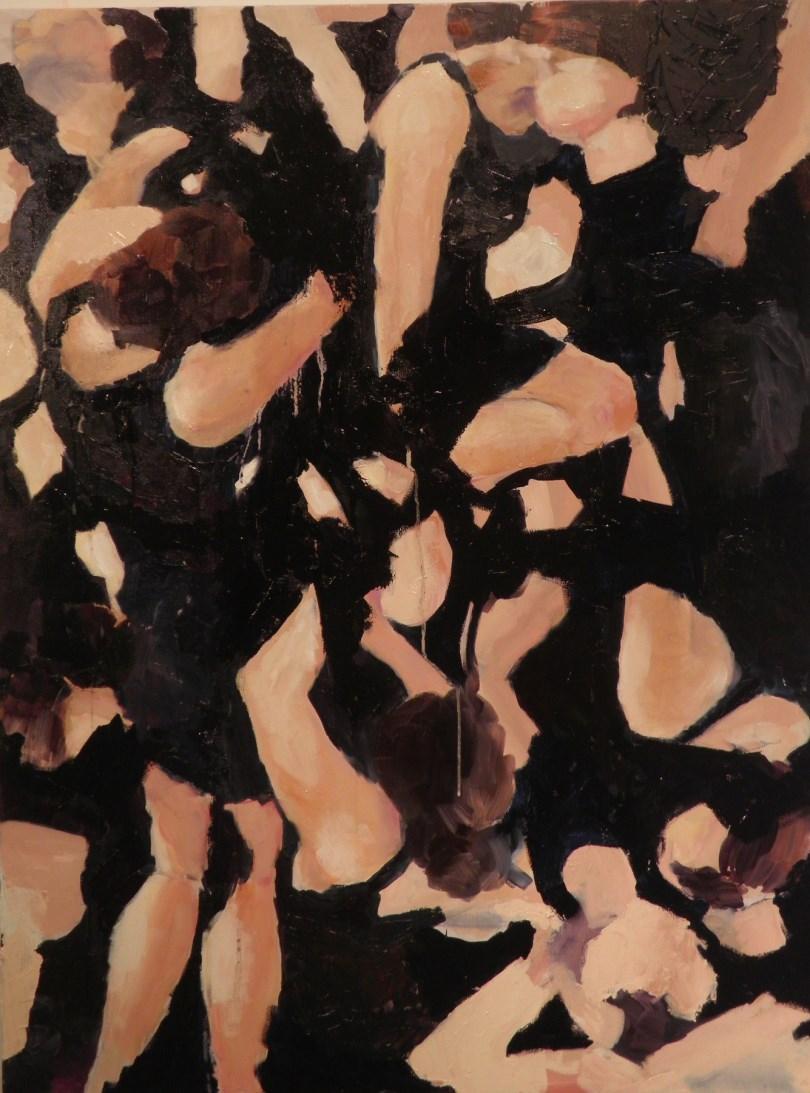 . Oil on canvas. 48 x 36 x 2 inches. 2011
. Oil on canvas. 48 x 36 x 2 inches. 2011
121
Ana Vizcarra Rankin
One of the first spells I learned was the binding spell. An example of sympathetic magic at its most elementary, the spell consists of taking a token that symbolizes something one wants to encapsulate, and binding it round and round with string, yarn, ribbon, strips of fabric, corn husks or whatever material is available. The bound object can then be treasured, shared, burnt as offering, buried for tempering, or set out to sea, depending on the intention of the practitioner.
 Pin Ball. Jute, miniature clothespins. 8 x 8 x 8 inches. 2012
Pin Ball. Jute, miniature clothespins. 8 x 8 x 8 inches. 2012
122
Jenny Rappaport
These works illustrate the torment and anxiety associated with being exposed & bound, physically and emotionally, in one’s struggle with her own sexual identity. In life we are faced with problems that seem unsolvable. Roadblocks are built up in our minds, creating emotional boundaries that don’t allow us to cope. Obsession and anxiety creep in, allowing that one seemingly-unsolvable problem consumes you. Your body is taken over, your insides are eaten away and all that is left is the shell of you. You are exposed and bound.
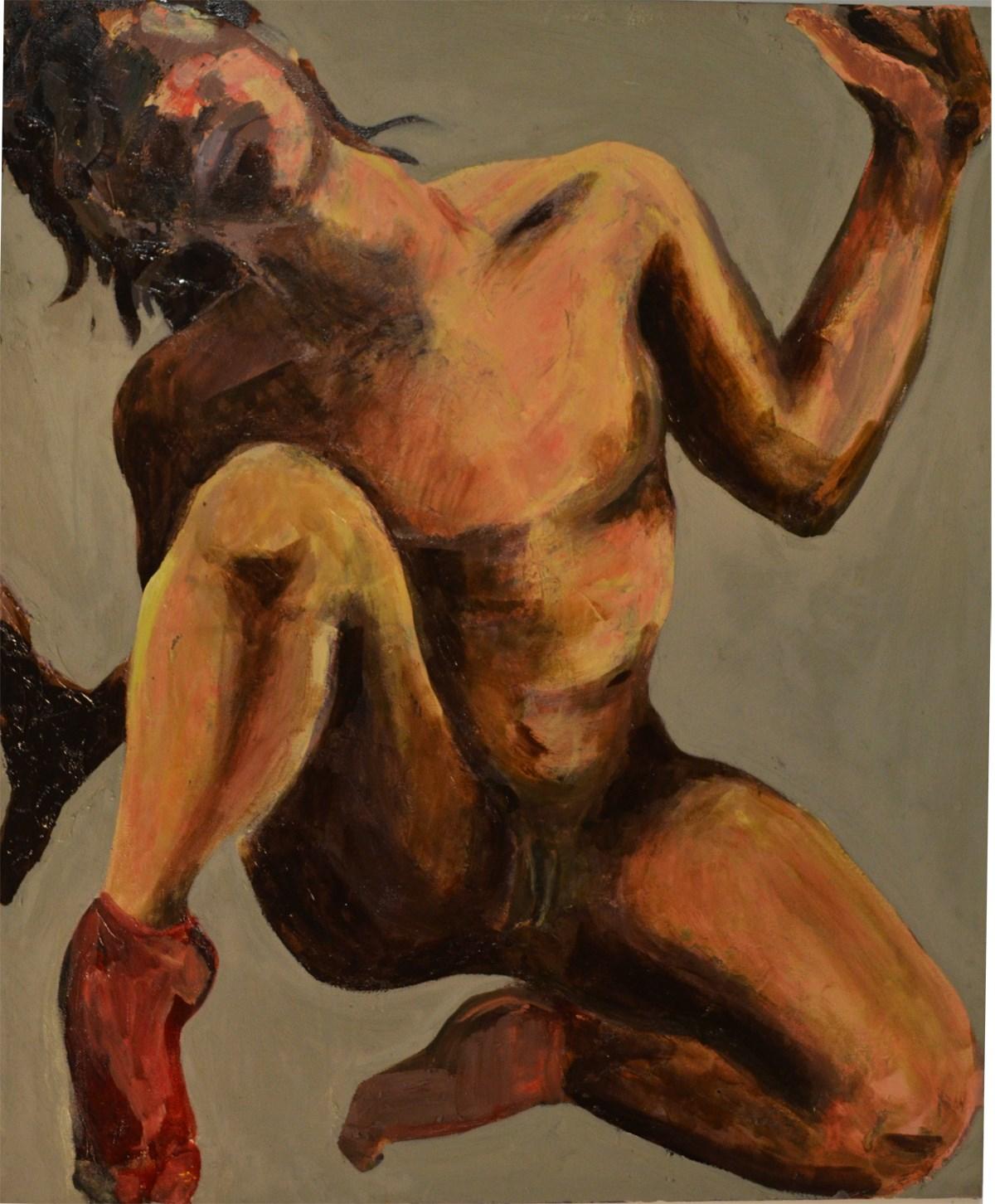 Shell of You 3. Oil on canvas. 40 x 40 inches. 2012
Shell of You 3. Oil on canvas. 40 x 40 inches. 2012
123
Wen Redmond
Into the Silence. Digitally melding several photographs, printed and mounted onto pre-treated cotton canvas. 40 x 31 inches. 2012
I am bound to my art completely; fully. It exacts beauty in my moments—eyefuls of paint, nature, and ways to marry the two—in my innovative fiber photographs.

124
Lynda A. N. Reyes
Every day, I could be bound between empty walls while someone looks the other way. I ask myself: Could this be imaginary? Those white walls are not actually enclosing me! They are not enclosing you, either! They could be our canvas for life! We can expand on those walls. Nobody can do it for us. I can create on them. You can create on them. Endless possibilities abound on every white canvas we encounter in life. I say to myself and to you: Explore, expand, and create. The artist in us can do it! Erase the blank.
 White Walls. Oil on canvas. 36 x 36 inches. 2012*
White Walls. Oil on canvas. 36 x 36 inches. 2012*
125
Launa D. Romoff
At times I feel bound by my everyday responsibilities. When those feelings (which I have imposed on myself) come up, I turn to my art. Able to express them, release them and exorcise them, I have learned to embrace boundaries. It is by setting boundaries that I have freed myself.
 #60 eternity. Mixed media collage. 18 x 14 inches. 2012
#60 eternity. Mixed media collage. 18 x 14 inches. 2012
126
Nicole Rubio
I grew up in a dysfunctional family where truth was denied. I had to find a way to express my real thoughts somehow. My grandmother, who lived with us, made wedding gowns for a living and I played with her scrap bag as a little girl. I was intrigued by the poufs of satin and silk. In my drawings, the folds in the fabrics of the skirt’s bustle are a metaphor for the flaps and crevices of my psychological landscape, which reveal and conceal.
 Bustle #11. Pastel on paper. 35 x 27 x 2 inches. 2012*
Bustle #11. Pastel on paper. 35 x 27 x 2 inches. 2012*
127
Katie Samuelson
My Lists. Reclaimed windows, metal pulleys and paper. 26.5 x 32 x 3.5 inches. 2012
My lists have been written and collected over the past year, and reflect tasks to do, groceries to buy, and more. There’s the ‘today’ list and the ‘sometime soon’ list. Am I bound by my lists? Can I see past the lists to see what is important and what can wait for another day’s list? My lists have been applied to reclaimed windows, representing architectural boundaries. The lists are layered, torn, wrinkled, as they obscure some but not all of the view through. I am reminded that my lists are arbitrary boundaries.

128
Ellen Schillace
Tied up in Grief. Mixed media, watercolor, pastel and ink. 22 x 30 inches. 2004
Bound up emotion, pain and grief.

129
Centa Schumacher
There are times when self-control, the medium of the level-headed, can be destructive. The bonds we place upon ourselves can become so tight that our very existence is painful. Eventually one must make a decision: continue with the pain of self-restriction, or deal with the fear of letting go.
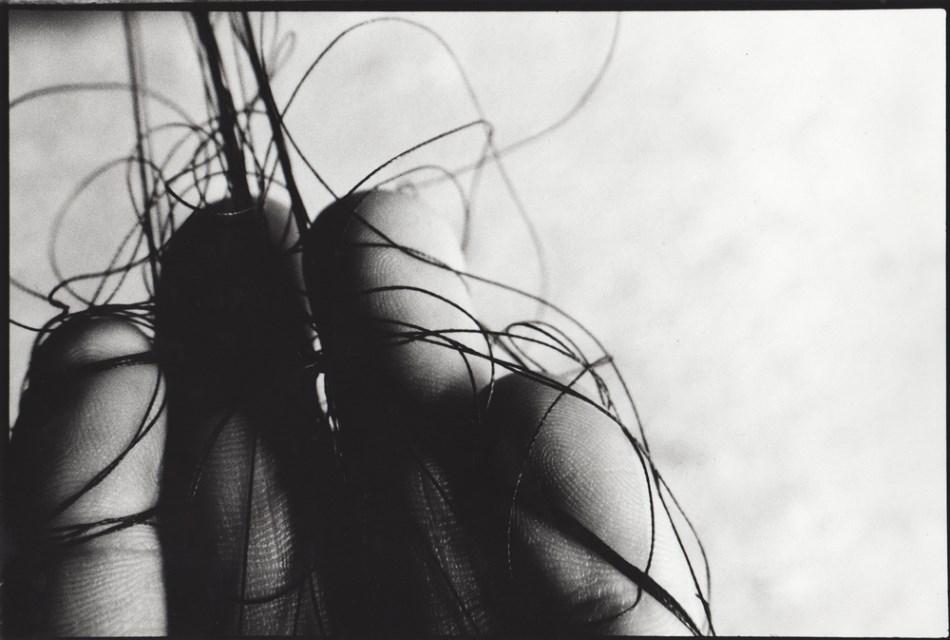 None But My Own (2). Silver Gelatin Photograph. 24 x 20 inches. 2008*
None But My Own (2). Silver Gelatin Photograph. 24 x 20 inches. 2008*
130
Sharon Shapiro
The women in my work evolve from the personal mythos of my memories, and disrupt the mores and expectations that bind women to their gender. As women we are bound by tradition, our families, and the situations in which we find ourselves. I have combined figures with places from my past, and with images steeped in context—black eyes, crowns of thorns, feathers, boxing gloves, neckties, and amusement rides—hoping to evoke the vicissitudes of memory and circumstance, and to cause viewers to question what lies beneath the surface.
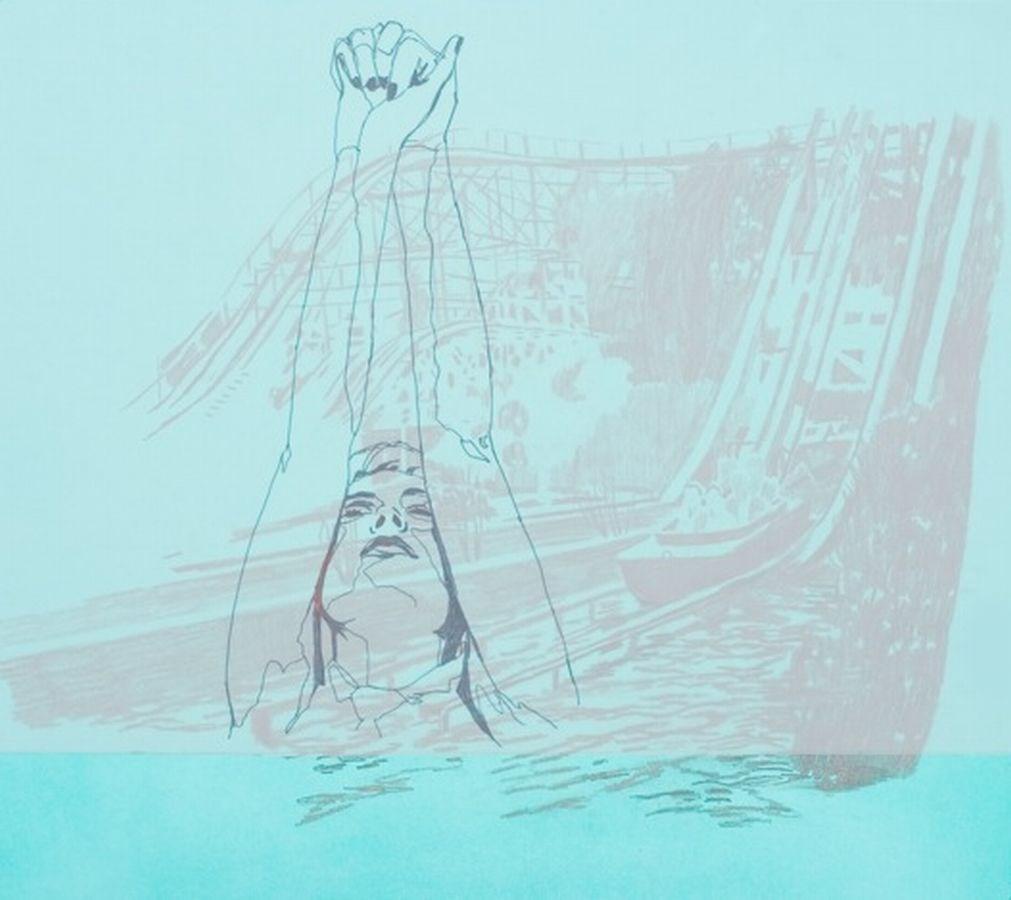 Lot’s Wife. Graphite on vellum and permanent marker on mylar. 26 x 24 inches. 2007
Lot’s Wife. Graphite on vellum and permanent marker on mylar. 26 x 24 inches. 2007
131
Soo Shin
Untitled: blind dog. Oil on canvas. 36 x 36 inches. 2012*
My work deals with people’s journey of faith, bound for the desired destination. People seek and long for the light of truth, love or even a savior in their lives. However, those don’t always arrive under our feet easily. The works I have created are about the uncertainty and vulnerability of keeping the faith in our pursuit of meaning, or rather our pilgrimage, through a long period of not-knowing, or blindness.

132
Marlene Siff
Truth, Politics, Lies. Acrylic on linen. 42.75 x 40 x 16 inches. 2011
I am concerned with communicating a sense of harmony, balance, order and spirituality. We are all confronted on a daily basis with the fragmentation of our non-linear lives, trying, as in a puzzle, to make all the pieces fit together to make sense of it all. My paintings, works on paper, and sculpture depict imagery of personal events and psychological issues. They are expressed through geometric shapes, color, light, space, texture, edges and movement, all interplaying with one another engaging the viewer to participate.

133
Pauline Silberman
The first series of Megiddo (Armageddon) Artifacts was comprised of oils of vessels and continued with charcoal drawings of tools, weapons, and jewelry. Artifacts are wordless witnesses of their time. Though thousands of years have passed, vessels, tools, weapons and jewelry remain with us, as does war. We feel a kinship with the people who made them. In that way, we are BOUND to the past. The artifacts are held in the Oriental Institute of Chicago, and are from an archeological dig by the University of Chicago in the 1930s.
 Armageddon Artifact: Axhead. Charcoal on paper. 22 x 30 inches. 1998
Armageddon Artifact: Axhead. Charcoal on paper. 22 x 30 inches. 1998
134
Deborah Silver
Not Good for Her. Wool and cotton. 20 x 16 inches. 2012*
Too many women know someone who is with a man that doesn’t allow her to be the person she could be; a man who dominates her personality and subjugates her needs with his own. Too often, she not only refuses to acknowledge this fact, but defends his attitudes. She cannot see that she is being victimized. She is bound. This piece is for all of the women who can only look helplessly on and just say, “He’s not good for her.”

136
Amy Siqveland
This piece explores how women are taught to view the world through rose-colored glasses, even when the backdrop is bleak. The scarf-bound model here is purposefully blinded, as we often are in love, but she is reclaiming a positive stance in the face of crisis—keeping hope alive even when the environment around her is pretty black and white in its outcome. She is not smiling, but is choosing to portray strength in optimism, while still including an awareness of her surroundings and the judgments about gender and anger.
 Blind Turn. Photograph. 10 x 15 inches. 2011
Blind Turn. Photograph. 10 x 15 inches. 2011
Madelyn Smoak
Bee UnBound. Mixed media necklace. 22 inches. 2012
The theme, ‘Bound’, intrigued me, and I interpreted it to include sequestration: cloistering, or being bound to a particular place, person or time.

137
Gail Stouffer
Rules for Girls. Gouache, mixed media monotype on paper. 12 x 9 inches. 2012*
I explore issues of identity and contradiction in my work. The concept of being bound by society’s conventions and the internal struggles that can create with us is a subject ripe for exploration. The images that speak most to me are those that use humor to uncover our hypocrisy of being bound to conventions that we perpetuate and embrace.

138
B. Avery Syrig
My work speaks about the forces in modern culture which I call molds for living that paradoxically both bind and enable our experience with other people. These molds for living, which are designated without our individual input, give us both boundaries that hinder and structures to grow from. Within this web of societal demands, personal dreams, and the needs of reality, stressful tensions and beautiful predicaments are found.
 Relief from Abundant Ties. Paper birch bark, fiber, handmade abaca paper, antique wood frame. 23 x 31 x 4 inches. 2011
Relief from Abundant Ties. Paper birch bark, fiber, handmade abaca paper, antique wood frame. 23 x 31 x 4 inches. 2011
139
Sally Schluter Tardella
My drawings are direct recalls of singular impressions or evidence of my attempt to summon a lost memory. Baling Twine is a tribute to my father, who insisted on the wrapping, knotting and saving of twine from each bale of hay and straw at the farm where I grew up.
 Baling Twine. Ink and white-out on paper. 22 x 30 inches. 2010*
Baling Twine. Ink and white-out on paper. 22 x 30 inches. 2010*
140
Lynne Todaro
Bound. Mixed media. 6 x 6 inches. 2011
My artwork comes from observing things in the everyday world. The objects are used to symbolize the struggle of the human spirit to survive. I believe a sense of humor is one of the most important survival tools.

141
Jill Torberson
Ponder. Steel and mixed media. 8 x 4 x 5 inches. 2012
These works represent feelings of house and home, and the emotions within those walls. The childlike house form is steel, juxtaposing strength and simplicity. I combine the concept of being bound with the tentativeness of suspension in each piece. The suspended wishbone represents hope and instability, which binds thought. The suspended heart in nails combines the limbo land of loss and support, which binds the heart. The suspended calipers hold the form of a house, or a letter, binding thoughts in our day to day lives.

142
Shirley Verrette
Bound, restricted, separated by differences of who, when, and where. For the past 13 years, I’ve divided my time between the U.S. and Turkey, and I’ve experienced these bonds of difference: culture, language, gender, religion, geographical border. I’ve also experienced the threads of connection between people, places, time. My recent work explores both the bonds of difference and the threads of connection.
 Vertiginous Heels. Gouache on paper. 26 x 40 inches. 2012
Vertiginous Heels. Gouache on paper. 26 x 40 inches. 2012
143
Jeane Vogel
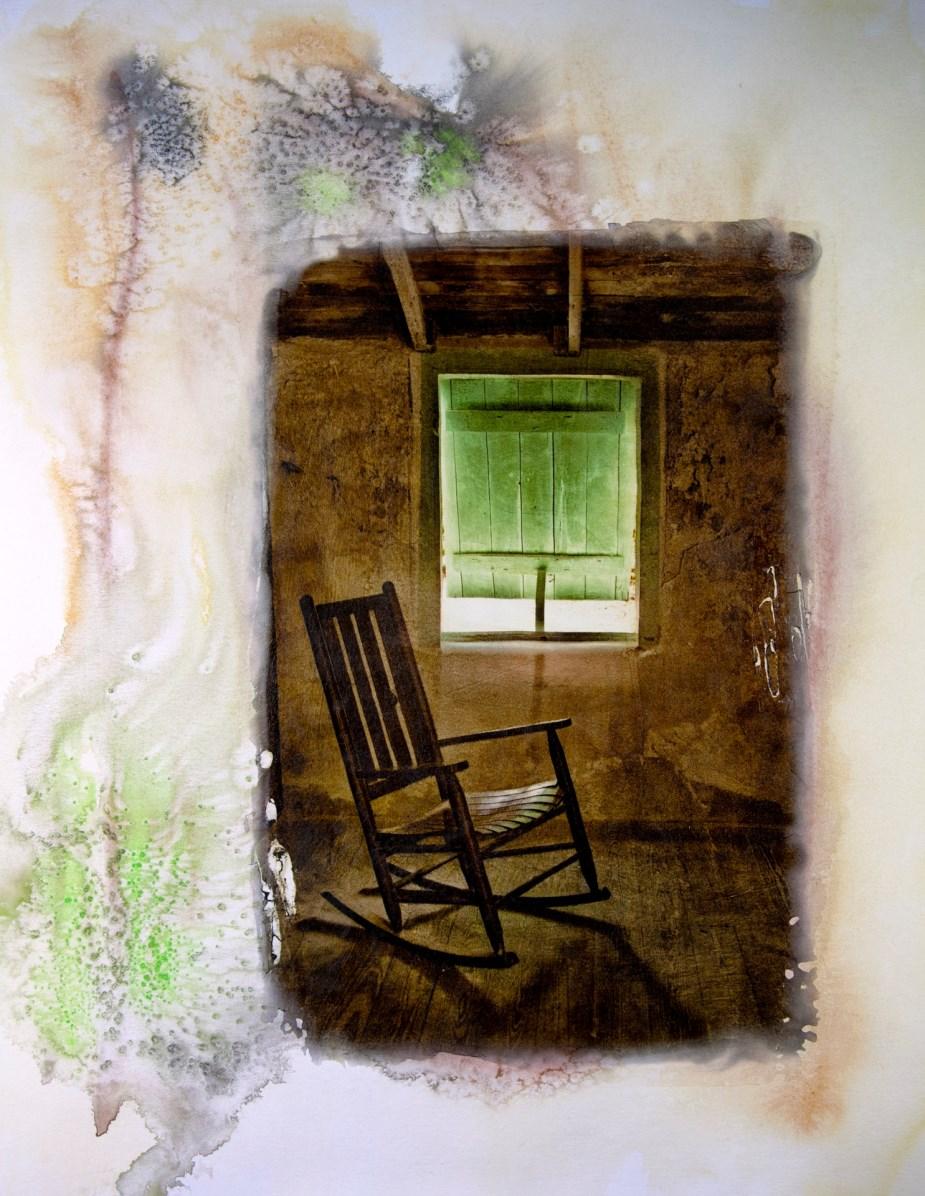
144
Waiting for Work. Work on paper. 20 x 16 inches. 2012
Jeane Vogel
Dancer. Work on paper. 18 x 24 inches. 2012
Bound to the land, bound to the water, bound to tradition, bound to hope, bound to possibility. We are defined by what inspires us and draws us back to our roots.
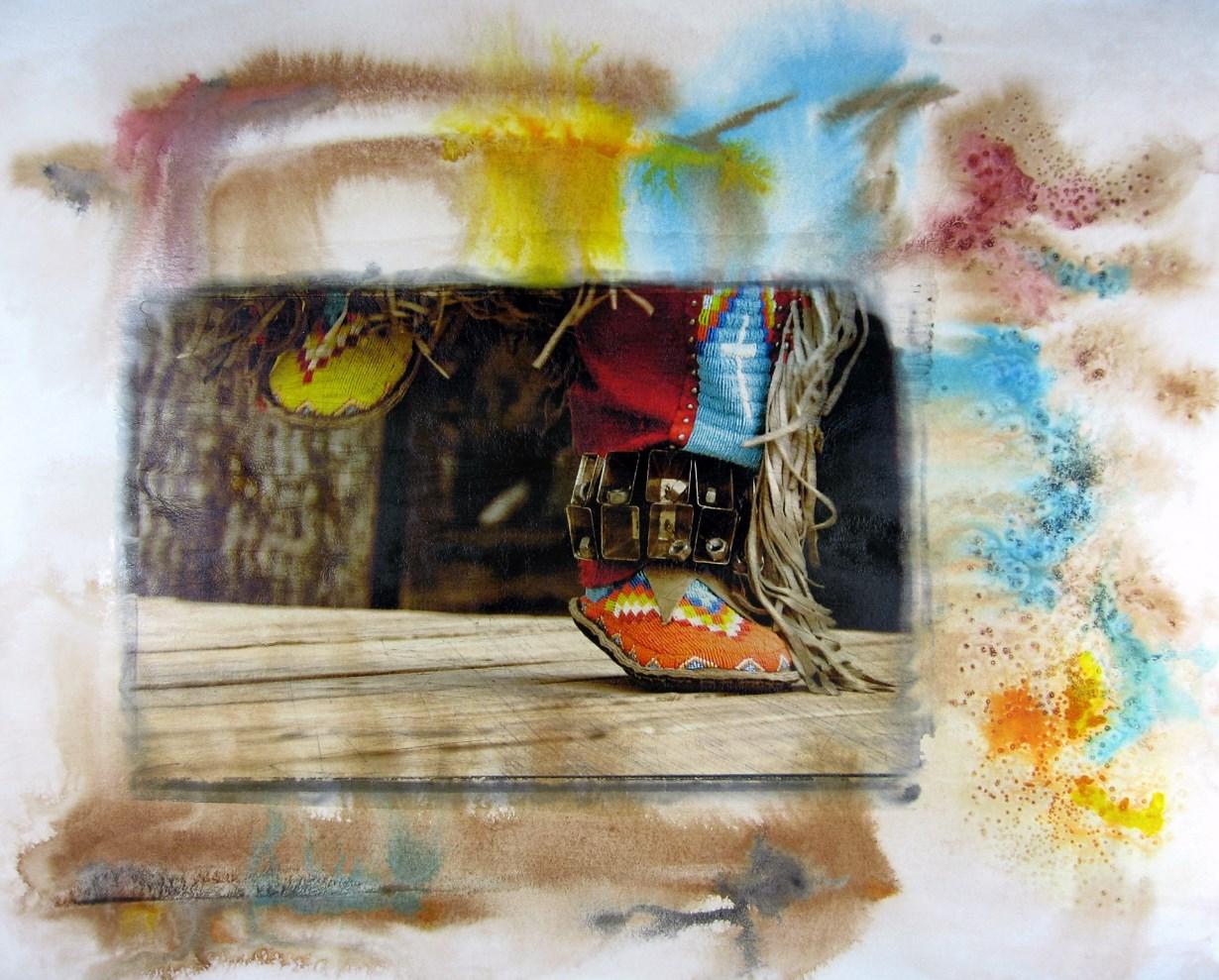
145
Susan von Gries
I believe in spiritual forces that attract and bind people together. ‘Love at first sight’ drew me to and continues to bind me to my husband, and while I share my DNA with my father, I am also bound to him by music. He was a musician and as a result, I developed a strong music appreciation that’s rooted in my childhood. Music is the muse for my paintings. It transports me to a place in my subconscious where I am able to express emotions from the music intuitively and spontaneously; where art and music are bound together.
 First Encounter. Mixed media on linen. 31.5 x 35.25 inches. 2010
First Encounter. Mixed media on linen. 31.5 x 35.25 inches. 2010
146
Jenny Walker
Fall in Line/Where are you Registered?
Beads, string, spoons. 16 x 28 inches. 2012
How many sets of silverware did you ask for? Weddings are not just a marriage between two people, but the progression from single and free to settled and bound. While getting ready for my wedding, I was overwhelmed by this expectation. Picking plates wasn’t just picking patterns, it was picking the life I would have. I felt bound by expectations to register for items I didn’t need, for a future life I didn’t have. Fall in Line came out of the internal struggle to reconcile my reality with the expectations of others.

147
Mona Waterhouse
Foot binding in China was prevalent for over one thousand years. The practice of binding girls feet started at age four. A cloth was tightly bound around their feet until they were broken, rendering them more or less unable to walk. The desired length of the foot was four inches long for a grown woman. The bound foot was a status symbol and it was only with lotus feet that a woman could marry well. Foot binding was finally outlawed in 1911, but it was not until the 1950s that it was fully stopped.
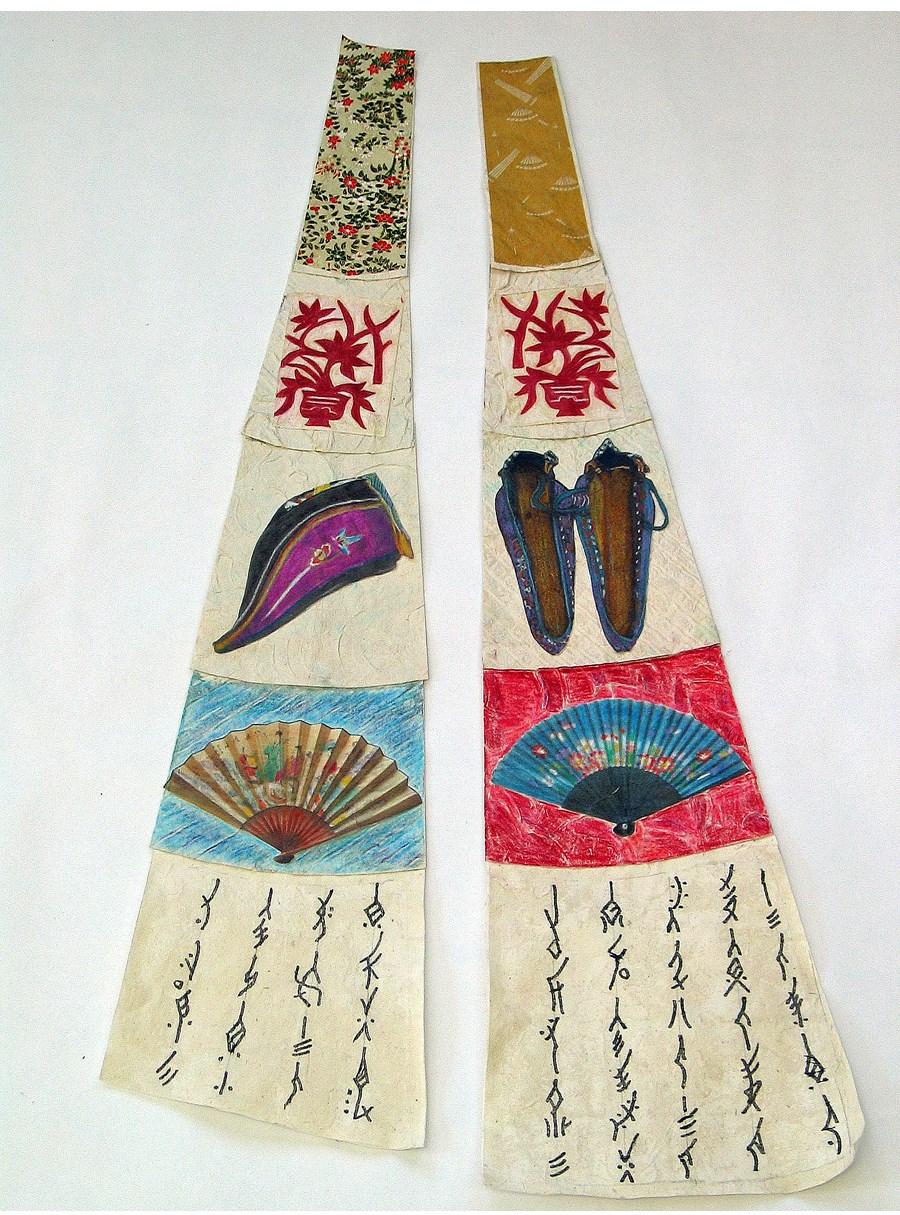 Bound Close-up. Fabric, handmade paper, colored pencil, collage, thread. 25 x 47 x 2 inches. 2008
Bound Close-up. Fabric, handmade paper, colored pencil, collage, thread. 25 x 47 x 2 inches. 2008
148
Mia Weiner
I hand-stitched the image of a girl floating from a house by a noose as an expression of feeling bound to the home. The image first seems whimsical, but when taking a closer look the violence of the image becomes evident. The conjoined bodies are intimate declarations that explore what a body is, what it means to share a body, and the boundaries of intimacy. The embroideries deal with being bound emotionally and physically to the home, and to the people around us.
 Table Runner. Hand embroidery on linen, pigment. 41 x 11 inches. 2012
Table Runner. Hand embroidery on linen, pigment. 41 x 11 inches. 2012
149
Joyce Ellen Weinstein
Moral Turning Point. Linoleum block print and silk screen with collage. 32 x 26 inches. 2010*
This work, from the series “The Blind Leading the Blind”, addresses the issue of the human capacity to live in denial, often bound by the refusal to see what is in front of their eyes (hence the blindfolded images). These self-inflicted blindfolds can bind people more easily into a herd mentality, making it easier to be a follower rather than a leader.

150
Ingrid Wells
Untitled. Oil on panel. 24 x 24 inches. 2012
Currently I am engaging in the conversation between subtlety and a violent gesture. This exploration has lead me to the painterly sensibilities utilized in Mend, a series of works executed in oil on panel or canvas over panel. These images depict the body suturing itself up in an effort not to lose its phalanges. Saving fingers from slipping away, these blood-red hands say to keep it together. They say that now is not the time to fall apart.

151
Candace Whittemore
Spun Gold. Fibers, wire, human hair extensions. 36 x 4 inches. 2012
There is no greater loss than the loss of self. It is our window to experience the world, the culmination of our senses, melting in synch. My work evaluates fragmentation of the self within various strains on the psyche. These explorations are prompted by my interpersonal relationships and cultural interactions. As a woman artist, social and cultural happenings that effect gender are interwoven within my work. Body image, gender roles and domestic issues that bind women are evaluated and brought to the surface.
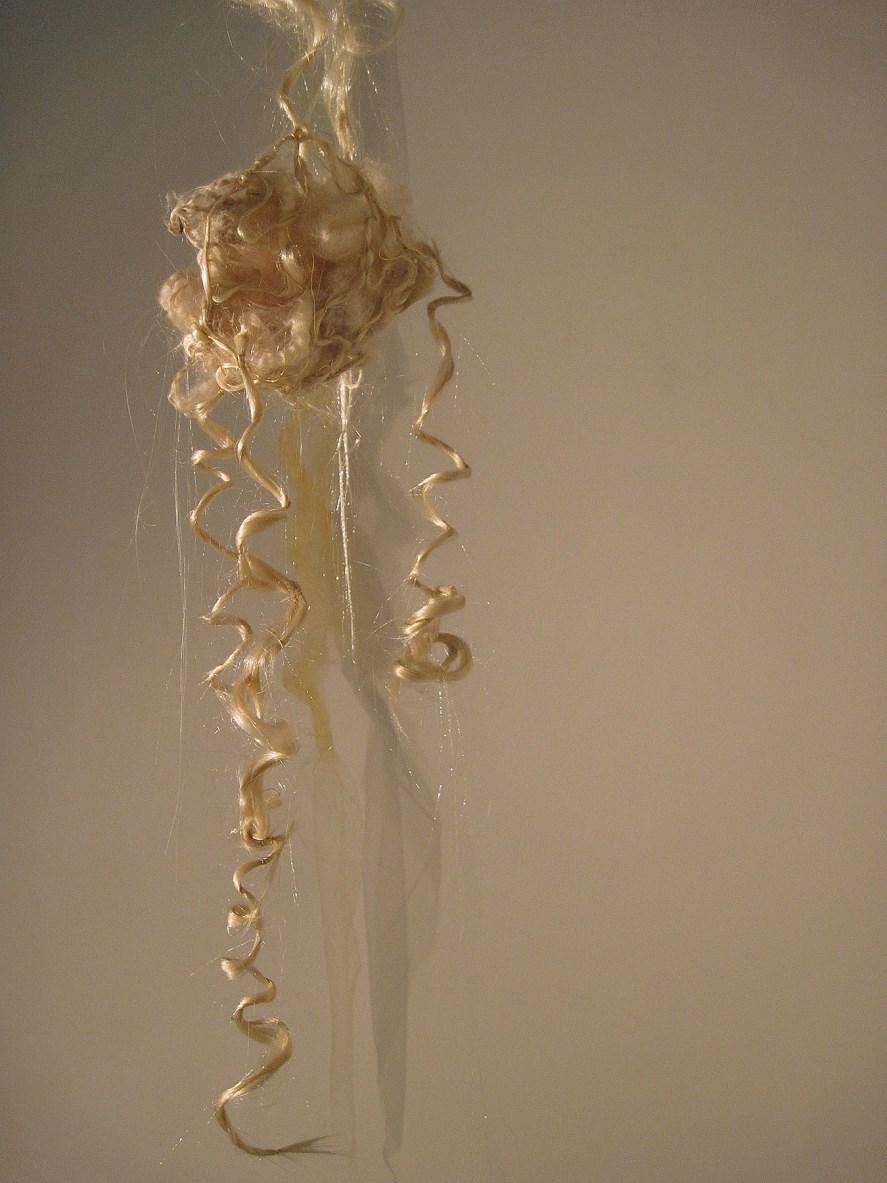
152
Tammy Jo Wilson
Bound by identity. A person’s identity is something as precious as life itself. Fearing how to express one’s identity can leave a person feeling trapped and dismayed. Fearing the identity society projects onto our bodies feels restrictive and punishing. Identity and fear take over the body surrounding it with darkness and tension. What are we made of, what substance forms our character, skin and bones? Look through the blackness. Identity is not a question to be answered, it is a strength to be built.
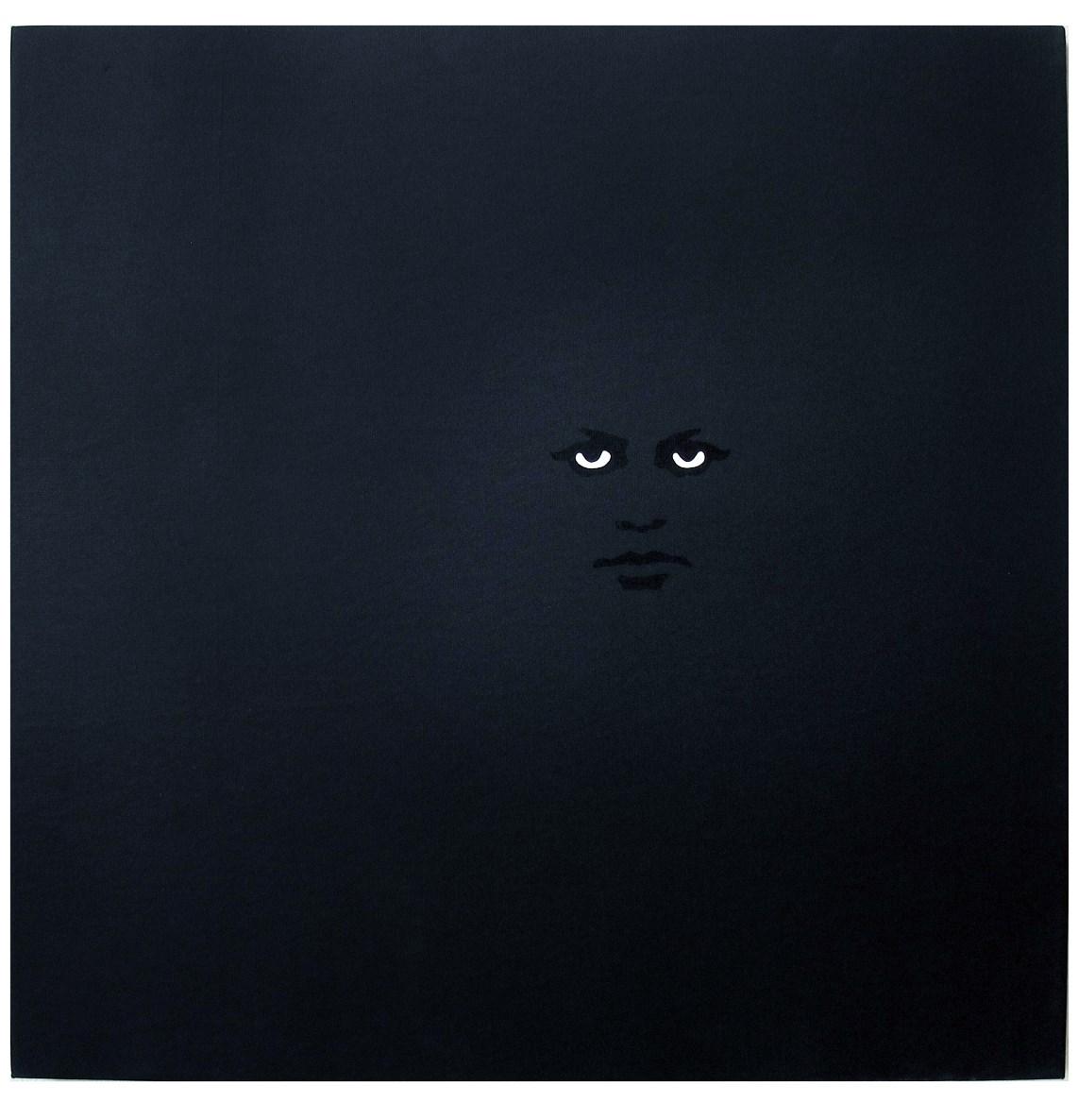 Black Face. Silkscreen on vinyl. 28 x 28 inches. 2008
Black Face. Silkscreen on vinyl. 28 x 28 inches. 2008
153
Sheila Winner
Bound to Fuck Up. Acrylic on board. 15 x 12 inches. 2012
Family, marriage, and children; ties that bind so tight I can’t breathe. Bound and gagged with invisible wrappings. To have my insides ripped open and trampled. No longer free to be myself, I must conform to the norm, and do what’s expected: keep my mouth shut and perpetuate the facade, be complacent, don’t put anything in writing, and white wash my thoughts because otherwise I’m bound to fuck up.

154
Joo Yeon Woo
Traveler’s Cup. Digital pigment print on archival paper. 25.5 x 39.4 inches. 2012
Traveler’s Cup embodies an artistic archive of my cultural displacement, and the attendant sense of instability and alienation. I collect images of my different surroundings and arranging them, per place, within the water glass that I drink from every day, in order to absorb that place visually and conceptually. These “portraits” of place convey my thoughts and feelings about the places where I construct the fluidity of identity, unfixed, open, and not subordinate to any specific society.

155
Mars Woodhill
With this work, I seek to examine the self-inflicted bonds and externally enforced confines that guide behavior. Though seemingly liberated from its restrictions, a border still exists: the canvas which contains it.
 Implosion I. Acrylic on canvas. 48 x 36 inches. 2010
Implosion I. Acrylic on canvas. 48 x 36 inches. 2010
156
Vera Ximenes
BOUND/UNBOUND. Oil, acrylic, glaze, wool, polymer and cold wax on canvas. 24 x 24 inches. 2012
There are no boundaries in art, only possibilities. If you are open to the possibilities you are not bound by anything. I want to be open. I don’t want to be limited by any medium, genre, gender or my heritage.
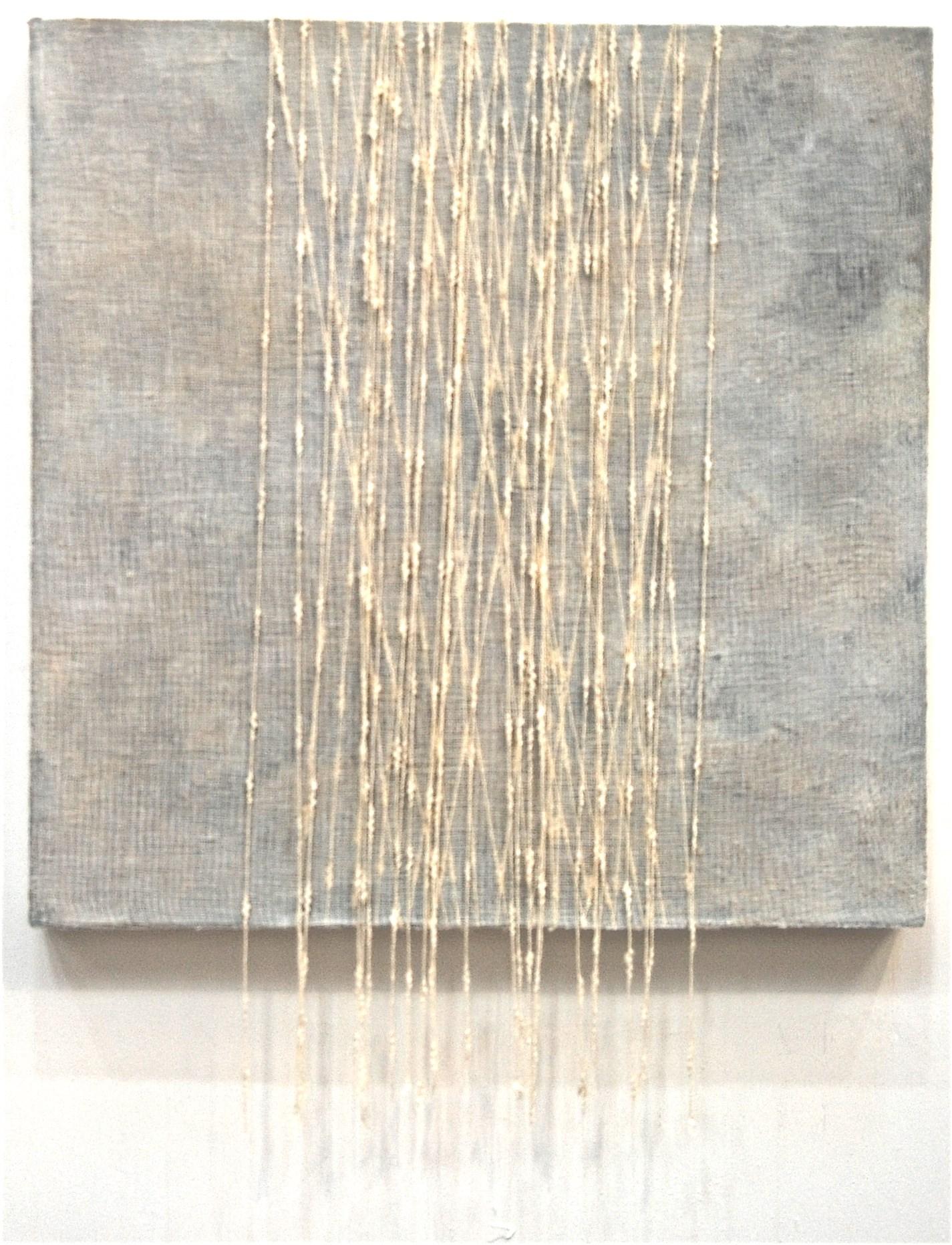
157
Nancy Youdelman
Over & Under. Mixed media relief. 17 x 22 x 3 inches. 2009
After we are dead and gone, it is the ordinary objects: the things we hold dear, wear and use every day, that hold secrets of the past. These objects take on a new significance when combined with other, seemingly unrelated objects such as pins, buttons, string and beeswax. It is my desire to bring to mind the fleeting, bittersweet manner in which we are bound to our existence on this earth.

158
Helen Zajkowski
My Father Said. Mixed media. 17 x 13 x 19 inches. 2008
My work addresses the psychological impact the words have on our psyche. The words that we hear from our parents and the rules we are impacted with by our government, the cultural and social environments become our mantras. These mantras become the navigating needles in our thinking and our behaviors. We become so bound by the internalized words that we confine our freedom and restrict our self expression.

159
ARTIST DIRECTORY
160
Olga Alexander www.olgaalexanderartsite.com
New York, New York
Dara Alter www.daraalter.com
Hillsborough, New Jersey
Suzanne Anan www.suzanneanan.com
Belmar, New Jersey
MGP Andersen www.mgpandersen.com
Fremont, California
Joan Arbeiter joan_arbeiter@hotmail.com
Metuchen, New Jersey
Katherine Armacost
www.katherinearmacost.com
Chapel Hill, North Carolina
Maria Barbachano
christinabarbachano@yahoo.com
Eureka, Montana
Temme Barkin-Leeds www.temmebarkin-leeds.com
Atlanta, Georgia
Mariona Barkus
www.marionabarkus.com
Culver City, California
Aileen Bassis
www.aileenbassis.com
Jersey City, New Jersey
Jacqueline Bennett jaxfb@aol.com New York, New York
Lauren Bettini
https://sites.google.com/site/laurenbettini
Edgewater, New Jersey
Suzanne Beutler
www.suzannebeutler.com
Ann Arbor, Michigan
Kelly Blevins
www.kblevins.com
Pittsburgh, Pennsylvania
Barbara Boissevain
www.barbaraboissevain.com
Palo Alto, California
Andrea Broyles
www.andreabroyles.com
Santa Fe, New Mexico
Corliss Chastain
www.corlisschastain.com
Portland, Maine
Kieran Collins
collins.kieran@gmail.com
San Francisco, California
161
Jeannine Cook
www.jeanninecook.com
Townsend, Georgia
Marcia Cooper www.marciacooperstudio.com
Long Island City, New York
Lauren Cross laurencross@mac.com
Weatherford, Texas
Debra Dake-Morrell ddake@valleywater.org
San Jose, California Lynn Dau www.lynndau.com
Los Altos, California
Mary Lou Dauray
www.maryloudauray.com
Sausalito, California
Deborah Davis
www.deborahdavisdesign.com
Lafayette, Colorado
Yvette Dede yvettedede@yahoo.com
Charleston, South Carolina
Sherri Denault and Margie Glass Sula www.margieglasssula.com
jamnsher@frontier.com
Piper City, Illinois
Laura Di Piazza
www.lauradipiazza.com
Norwich, Vermont
Vanessa Diaz www.vdiazart.com
Tampa, Florida
Debra Dobkin
www.art.debradobkin.com
Studio City, California
Jennifer Dunlap
www.jenniferleighdunlap.com
New York, New York
Emily Dvorin
www.emilydvorin.com
Kentfield, California
Lauren Evans www.ledearts.com
Culver City, California
Catherine Evans
www.catherineevansart.com
Maynard, Massachusetts
Jennifer Ewing
www.jenniferewing.com
San Francisco, California
Jada Fabrizio
www.jadafab.com
Maywood, New Jersey
162
Linda King Ferguson
www.lindakingferguson.com Au Train, Michigan
Dyanne Fiorucci www.fiorucci-art.com
Phoenix, Arizona
Ellen Freyer freyere@sbcglobal.net
Los Angeles, California
Sara Friedlander www.sarafriedlander.com
Santa Cruz, California
Chiara Galimberti chiaragalimberti.com
Chicago, Illinois
Margaret ‘Margo’ Garces www.margoandcompany.com
Gilroy, California
Jenne Giles
www.jennegiles.com
San Francisco, California
Marguerite Gilligan marguerite@gilligan-steinberg.com
San Francisco, California
Laine Godsey www.lainegodsey.daportfolio.com
Philadelphia, Pennsylvania
Janice Gossman stormkinger@msn.com
Garwood, New Jersey
Guerrilla Gowns
https://www.facebook.com/GuerrillaGowns Rancho Santa Margarita, California
Katherine Greco dimension@3dimillus.com Southampton, Pennsylvania
Karen M. Gutfreund www.karengutfreund.com
San Jose, California
Kely Hammargren www.hankkellyartists.com
Berkeley, California
Teresa Harris tharris@missouriwestern.edu
St. Joseph, Missouri
Martha Markline Hopkins
www.mahopkins.blogspot.com
Tuscaloosa, Alabama
Jan Hoy www.sculpture.jhoydesign.com
Coupeville, Washington
Tehniyet Hussain jiaanji@gmail.com
Carmel, Indiana
163
Bara Jichova
www.barajichova.org
New York, New York
Joy Johnson www.joyjohnsonart.com
Fresno, California
Robin M Jordan
www.robinmjordan.com
Brooklyn, New York
Joanna Kidd
www.JoannaKidd.com
Davis, California
Jappie King Black
www.kingblack.com
Brockport, New York
Judith Kornett
www.JudithKornettArts.com
Greenbelt, Maryland
Bernice Sokol Kramer
www.bernicesokolkramer.com
New York, New York
Diana Krevsky
dkrevsky@interx.net
Vallejo, California
Linda Kunik www.lkunik.com
Beverly Hills, California
Kristin Kyono
www.kristinkyono.com
Oakland, California
Olga Lah olgalah@gmail.com
Long Beach, California
Beth Lakamp
www.bettsvando.com
Fenton, Missouri
Elizabeth Larrabee
etlarrabee@roadrunner.com
Buffalo, New York
Laurel Lee
hippodameia_2000@yahoo.com
Oakland, California
Linda Levinson
llevinson@uwlax.edu
La Crosse, Wisconsin
Elizabeth Lind
www.elizabethlind.net
Wakefield, Rhode Island
Harriet Livathinos
harrietlivathinos@yahoo.com
Woodstock, New York
Aline Lotter
www.paintingsbyaline.com
Manchester, New Hampshire
164
Sarah Lubin
www.sarahlubin.com
Brooklyn, New York
Virginia Maksymowicz
virginia.maksymowicz@fandm.edu
Philadelphia, Pennsylvania
Karlene McConnell
www.karlenemcconnell.com
Ormond Beach, Florida
Kelsey McDonnell www.kelseymcdonnell.com
Buffalo, Wyoming Allison McElroy
www.allisonmcelroy.com
Jacksonville, Alabama
Elizabeth Mesa-Gaido
www.elizabethmesa-gaido.com
Morehead, Kentucky
Beverly Mills
www.studiobeverly.com
San Francisco, California
Jennifer Mondfrans
www.jennifermondfrans.com
San Francisco, California
Patty Neal www.pattyneal.com
Brooklyn, New York
Tae Nelson
www.taenelson.com
Webster, New Hampshire
Jean Nerenberg
www.jeannerenberg.com
Chicago, Illinois
Martha Nicholson
marthanicholson47@gmail.com
Tarrytown, New York
Peggy Nino www.pnino.com
Eldorado, Texas
Michele Noiset
www.michelenoisetpastels.com
East Sandwich, Massachusetts
Tanya Nolan
www.tmnfineart.com
Los Angeles, California
Taryn O’Reilly toreilly18@gmail.com
Glenside, Pennsylvania
Mervi Pakaste
mpakaste@gmail.com
Manhattan, Kansas
Bhanu Palam
www.bhanuspalam.com
Syosset, New York
165
Margaret Parker
www.margaretparkerstudio.com
Ann Arbor, Michigan
Kate Paul
www.paulstudiosllc.com
Livonia, Michigan
Nancy Peach
www.nancypeach.com
Sausalito, California
Diane Pepe
www.dianepepe.com
Philadelphia, Pennsylvania
Jane Peterman
www.janepeterman.com
Palo Alto, California
Laura Petrovich-Cheney
www.lauracheney.com
Asbury Park, New Jersey
Jane Pettit
www.janepettit.com
Bethesda, Maryland
Roxanne Phillips
www.roxannephillips.com
St. Louis, Missouri
Jean Plough
www.jeanplough.com
Philadelphia, Pennsylvania
Lorena Pugh
www.lorenapugh.com
North Kingstown, Rhode Island
Nora Raggio
nora_gen@yahoo.com
Palo Alto, California
Lauren Rago
www.laurenmrago.com
Greenwich, Connecticut
Ana Vizcarra Rankin
www.avrankin.com
Philadelphia, Pennsylvania
Jenny Rappaport
www.jennyrap.com
New York, New York
Wen Redmond
www.wenredmond.com
Strafford, New Hampshire
Lynda A. N. Reyes
www.Lyndaanreyes.com
Glendale, California
Launa D. Romoff
www.launadromoff.com
Los Angeles, California
Nicole Rubio
www.nicolerubio.com
El Cerrito, California
166
Katie Samuelson
ksamuelson@cox.net
Cheshire, Connecticut
Ellen Schillace ellenschillace427@gmail.com
St. Paul, Minnesota
Centa Schumacher
www.centaschumacher.com
San Francisco, California
Sharon Shapiro
www.sharonshapiro.com
Louisa, Virginia
Soo Shin
www.sooshin.org
Chicago, Illinois
Marlene Siff
www.marlenesiff.com
Westport, Connecticut
Pauline Silberman
www.paulinesilbermanpaintings.com
Chicago, Illinois
Deborah Silver
silverhaggerty@sbcglobal.net
Cleveland Hts., Ohio
Amy Siqveland
www.amysiqveland.com
Minneapolis, Minnesota
Madelyn Smoak
www.madelynsmoak.com
Durham, North Carolina
Gail Stouffer www.gailstouffer.com
Bulverde, Texas
B.Avery Syrig www.baverysyrig.com
Cortlandt Manor, New York
Sally Schluter Tardella
www.sallyschlutertardella.com
Bloomfield, Michigan
Lynne Todaro
lynnetodaro@comcast.net
San Jose, California
Jill Torberson
www.jilltorberson.com
Portland, Oregon
Shirley Verrette
www.cargocollective.com/shirleyverrette
New York, New York
Jeane Vogel
www.vogelpix.com
St. Louis, Missouri
Susan von Gries
www.susanvongries.com
University Park, Florida
167
Jenny Walker
jwalkerartist@gmail.com
Salem, Massachusetts
Mona Waterhouse
www.monawaterhouse.com
Peachtree City, Georgia
Mia Weiner
www.miaweiner.com
Chicago, Illinois
Joyce Ellen Weinstein
www.joyceellenweinstein.com
Milford, Pennsylvania
Ingrid Wells
www.ingridvwells.com
San Francisco, California
Candace Whittemore
www.candacewhittemore.com
Savannah, Georgia
Tammy Jo Wilson
www.tammyjowilson.com
Milwaukie, Oregon
Sheila Winner
www.sheilawinner.com
San Jose, California
Joo Yeon Woo
www.spacekite.net
Boulder, Colorado
Mars Woodhill
www.marswoodhill.com
Houston, Texas
Vera Ximenes
www.veraximenes.com
Sacramento, California
Nancy Youdelman
www.nancyyoudelman.com
Clovis, California
Helen Zajkowski
www.helenzajkowski.webs.com
Stamtord, Connecticut
168

 Priscilla Otani, WCA President
Priscilla Otani, WCA President



 Olga Alexander
Olga Alexander
 Gathering of Brothers. Acrylic on canvas. 16 x 20 inches. 2012
Gathering of Brothers. Acrylic on canvas. 16 x 20 inches. 2012
 Woman In Blue. Oil on canvas. 20 x 30 inches. 2012
Woman In Blue. Oil on canvas. 20 x 30 inches. 2012
 Sufficient. Oil on canvas. 16 x 12 inches. 2011*
Sufficient. Oil on canvas. 16 x 12 inches. 2011*

 Literal. Gesso, handmade paper, yarn on panel. 12 x 12 inches. 2012*
Literal. Gesso, handmade paper, yarn on panel. 12 x 12 inches. 2012*
 The Lovers. Watercolor pencil on paper. 42 x 32 inches. 2010*
The Lovers. Watercolor pencil on paper. 42 x 32 inches. 2010*
 Arrested Frame with Baked Turkey. Acrylic on gessobard. 16 x 20 inches. 2012
Arrested Frame with Baked Turkey. Acrylic on gessobard. 16 x 20 inches. 2012

 The Melting Pot. Acrylic on canvas. 41 x 31 inches. 2006
The Melting Pot. Acrylic on canvas. 41 x 31 inches. 2006


 Bound 13. Ceramic. 20 x 30 x 4 inches. 2012
Bound 13. Ceramic. 20 x 30 x 4 inches. 2012
 Amazonian Interior. Oil on canvas. 30 x 40 inches. 2011
Amazonian Interior. Oil on canvas. 30 x 40 inches. 2011
 Fabric. Charcoal on paper. 48 x 36 inches. 2012
Fabric. Charcoal on paper. 48 x 36 inches. 2012
 Ghost Hangar No.3. Archival inkjet digital print. 40 x 23 inches. 2012*
Ghost Hangar No.3. Archival inkjet digital print. 40 x 23 inches. 2012*
 Cage Series II. Acrylic on paper. 12 x 10 inches. 2010
Cage Series II. Acrylic on paper. 12 x 10 inches. 2010

 Betrothal 1: Bashkir Rite. Found image transfer and oil on panel. 24 x 36 inches. 2012
Betrothal 1: Bashkir Rite. Found image transfer and oil on panel. 24 x 36 inches. 2012
 Distant Traces II: the Sarmento. Silverpoint on prepared paper. 14 x 18 inches. 2012
Distant Traces II: the Sarmento. Silverpoint on prepared paper. 14 x 18 inches. 2012
 Untitled 1. C-Print mounted. 30 x 20 inches. 2012
Untitled 1. C-Print mounted. 30 x 20 inches. 2012


 Point of View. Acrylic on canvas. 20 x 24 inches. 2010
Point of View. Acrylic on canvas. 20 x 24 inches. 2010

 Couple On Stairs. Archival inkjet print. 13 x 9 inches. 2005
Couple On Stairs. Archival inkjet print. 13 x 9 inches. 2005
 Hand #5. Charcoal on paper. 51.5 x 40 inches. 2012*
Hand #5. Charcoal on paper. 51.5 x 40 inches. 2012*
 Sherri Denault and Margie Glass Sula
Sherri Denault and Margie Glass Sula
 Kneel. Oil pastels and acrylic paint on canvas. 20 x 20 inches. 2012
Kneel. Oil pastels and acrylic paint on canvas. 20 x 20 inches. 2012

 In The Shadows. Oil on canvas. 11 x 9 inches. 2011
In The Shadows. Oil on canvas. 11 x 9 inches. 2011

 Spun. Sculptor’s armature wire, slinkies, cable ties. 12 x 19 x 19 inches. 2012
Spun. Sculptor’s armature wire, slinkies, cable ties. 12 x 19 x 19 inches. 2012
 Nomura. Plastic gimp, beads, plastic gimp rolled, wire. 48 x 12 x 19 inches. 2010
Nomura. Plastic gimp, beads, plastic gimp rolled, wire. 48 x 12 x 19 inches. 2010
 Slinky. Mixed media with slinky. 57 x 6 x 6 inches. 2012*
Slinky. Mixed media with slinky. 57 x 6 x 6 inches. 2012*

 Lashed Ark. Cardboard, basket, paper, twine, metal and wood. 15 x 7 x 7 inches. 2012
Lashed Ark. Cardboard, basket, paper, twine, metal and wood. 15 x 7 x 7 inches. 2012
 Tricked By Fiction. Photograph. 18 x 24 inches. 2012
Tricked By Fiction. Photograph. 18 x 24 inches. 2012
 Coherence 23. Cut linen, acrylic, and pine. 48 x 36 x 2 inches. 2012
Coherence 23. Cut linen, acrylic, and pine. 48 x 36 x 2 inches. 2012



 Cops and Robbers. Paper. 52 x 32 inches. 2012
Cops and Robbers. Paper. 52 x 32 inches. 2012
 Captive. Digital photograph inkjet print on glossy paper. 22.75 x 18.75 inches. 2011
Captive. Digital photograph inkjet print on glossy paper. 22.75 x 18.75 inches. 2011
 Jenne Giles
Jenne Giles
 Swanns Way. Glass and paper. 12 x 7 x 7 inches. 2012
Swanns Way. Glass and paper. 12 x 7 x 7 inches. 2012
 Family Portrait. Digital c-print. 20 x 24 inches. 2012
Family Portrait. Digital c-print. 20 x 24 inches. 2012


 Cocoon. Vinyl Jelly Yarn, tree bark, cotton canvas. 8 x 10 inches. 2012
Cocoon. Vinyl Jelly Yarn, tree bark, cotton canvas. 8 x 10 inches. 2012



 Corinthian White. Acrylic on shaped canvas. 24 x 24 x 3 inches. 2012*
Corinthian White. Acrylic on shaped canvas. 24 x 24 x 3 inches. 2012*


 Adultery 3. Hand made collage, photographs. 16 x 20 inches. 2012
Adultery 3. Hand made collage, photographs. 16 x 20 inches. 2012

 MakeMe. Steel. 17 x 16.25 inches. 2011
MakeMe. Steel. 17 x 16.25 inches. 2011

 Bound Falling Figure. Grapevine bark. 12 x 4 x 2 inches. 2012
Bound Falling Figure. Grapevine bark. 12 x 4 x 2 inches. 2012
 Bully For You. Wood fired ceramic, wall hung. 18 x 20 x 8 inches. 2010
Bully For You. Wood fired ceramic, wall hung. 18 x 20 x 8 inches. 2010

 Hostage. Graphite and acrylic on paper. 21 x 21 inches. 2004
Hostage. Graphite and acrylic on paper. 21 x 21 inches. 2004
 Escape. Root, gold wire, wooden frame. 20 x 24 x 10 inches. 2012
Escape. Root, gold wire, wooden frame. 20 x 24 x 10 inches. 2012

 Olga Lah
Olga Lah






 No Escape. Pastels on paper. 17 x 21 x 2 inches. 2009
No Escape. Pastels on paper. 17 x 21 x 2 inches. 2009
 Portrait of Sabrin. Paper. 17 x 11 inches. 2012
Portrait of Sabrin. Paper. 17 x 11 inches. 2012
 Coffee Table. Oil on canvas. 20 x 16 x 2 inches. 2012
Coffee Table. Oil on canvas. 20 x 16 x 2 inches. 2012
 Bound. Hydrostone. 17 x 12 x 4 inches. 2012
Bound. Hydrostone. 17 x 12 x 4 inches. 2012

 Broken Home. Acrylic on canvas. 22 x 28 inches. 2012
Broken Home. Acrylic on canvas. 22 x 28 inches. 2012

 Then & Now I. Mixed media. 10 x 20 inches. 2012
Then & Now I. Mixed media. 10 x 20 inches. 2012
 Haunted Sanctuaries #3. Black and white collage. 24 x 18 inches. 2012*
Haunted Sanctuaries #3. Black and white collage. 24 x 18 inches. 2012*
 No. Oil on board. 16 x 12 inches. 2011
No. Oil on board. 16 x 12 inches. 2011

 A.E.B. 47. Acrylic on wood panel. 30 x 30 x 2 inches. 2012
A.E.B. 47. Acrylic on wood panel. 30 x 30 x 2 inches. 2012


 Peggy Nino
Closed Door. Oil on paper. 22 x 30 inches. 2012
Peggy Nino
Closed Door. Oil on paper. 22 x 30 inches. 2012
 Censored. Pastel. 18 x 24 inches. 2012
Censored. Pastel. 18 x 24 inches. 2012
 Release Me. Ink and crayon on Vellum. 36 x 36 inches. 2010
Release Me. Ink and crayon on Vellum. 36 x 36 inches. 2010
 Yellow. Wood, fabric, glass, fabric pen, and thread. 10 x 12 x 3 inches. 2012
Yellow. Wood, fabric, glass, fabric pen, and thread. 10 x 12 x 3 inches. 2012

 Dual Vision. Oil on canvas. 16 x 20 inches. 2011
Dual Vision. Oil on canvas. 16 x 20 inches. 2011


 Ruinous Means. Pencil on vellum. 20 x 16 inches. 2012
Ruinous Means. Pencil on vellum. 20 x 16 inches. 2012
 Column III. White poplar, white marble stones, brass rods. 15 x 4.5 x 5.5 inches. 2011*
Column III. White poplar, white marble stones, brass rods. 15 x 4.5 x 5.5 inches. 2011*
 To Divorce or Not. Acrylic on canvas. 24 x 24 inches. 2012*
To Divorce or Not. Acrylic on canvas. 24 x 24 inches. 2012*
 Good Bye Clancy. Salvaged boat wood. 15 x 23.5 inches. 2011
Good Bye Clancy. Salvaged boat wood. 15 x 23.5 inches. 2011

 Roxanne Phillips
Roxanne Phillips

 Pear #11. Oil on linen framed in wood. 38 x 20 x 2 inches. 2010
Pear #11. Oil on linen framed in wood. 38 x 20 x 2 inches. 2010

 . Oil on canvas. 48 x 36 x 2 inches. 2011
. Oil on canvas. 48 x 36 x 2 inches. 2011
 Pin Ball. Jute, miniature clothespins. 8 x 8 x 8 inches. 2012
Pin Ball. Jute, miniature clothespins. 8 x 8 x 8 inches. 2012
 Shell of You 3. Oil on canvas. 40 x 40 inches. 2012
Shell of You 3. Oil on canvas. 40 x 40 inches. 2012

 White Walls. Oil on canvas. 36 x 36 inches. 2012*
White Walls. Oil on canvas. 36 x 36 inches. 2012*
 #60 eternity. Mixed media collage. 18 x 14 inches. 2012
#60 eternity. Mixed media collage. 18 x 14 inches. 2012
 Bustle #11. Pastel on paper. 35 x 27 x 2 inches. 2012*
Bustle #11. Pastel on paper. 35 x 27 x 2 inches. 2012*


 None But My Own (2). Silver Gelatin Photograph. 24 x 20 inches. 2008*
None But My Own (2). Silver Gelatin Photograph. 24 x 20 inches. 2008*
 Lot’s Wife. Graphite on vellum and permanent marker on mylar. 26 x 24 inches. 2007
Lot’s Wife. Graphite on vellum and permanent marker on mylar. 26 x 24 inches. 2007


 Armageddon Artifact: Axhead. Charcoal on paper. 22 x 30 inches. 1998
Armageddon Artifact: Axhead. Charcoal on paper. 22 x 30 inches. 1998

 Blind Turn. Photograph. 10 x 15 inches. 2011
Blind Turn. Photograph. 10 x 15 inches. 2011


 Relief from Abundant Ties. Paper birch bark, fiber, handmade abaca paper, antique wood frame. 23 x 31 x 4 inches. 2011
Relief from Abundant Ties. Paper birch bark, fiber, handmade abaca paper, antique wood frame. 23 x 31 x 4 inches. 2011
 Baling Twine. Ink and white-out on paper. 22 x 30 inches. 2010*
Baling Twine. Ink and white-out on paper. 22 x 30 inches. 2010*


 Vertiginous Heels. Gouache on paper. 26 x 40 inches. 2012
Vertiginous Heels. Gouache on paper. 26 x 40 inches. 2012


 First Encounter. Mixed media on linen. 31.5 x 35.25 inches. 2010
First Encounter. Mixed media on linen. 31.5 x 35.25 inches. 2010

 Bound Close-up. Fabric, handmade paper, colored pencil, collage, thread. 25 x 47 x 2 inches. 2008
Bound Close-up. Fabric, handmade paper, colored pencil, collage, thread. 25 x 47 x 2 inches. 2008
 Table Runner. Hand embroidery on linen, pigment. 41 x 11 inches. 2012
Table Runner. Hand embroidery on linen, pigment. 41 x 11 inches. 2012



 Black Face. Silkscreen on vinyl. 28 x 28 inches. 2008
Black Face. Silkscreen on vinyl. 28 x 28 inches. 2008


 Implosion I. Acrylic on canvas. 48 x 36 inches. 2010
Implosion I. Acrylic on canvas. 48 x 36 inches. 2010


